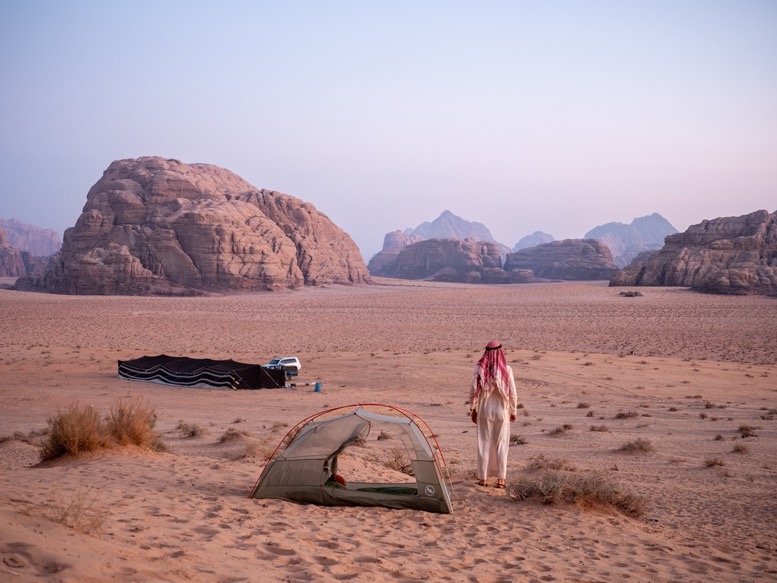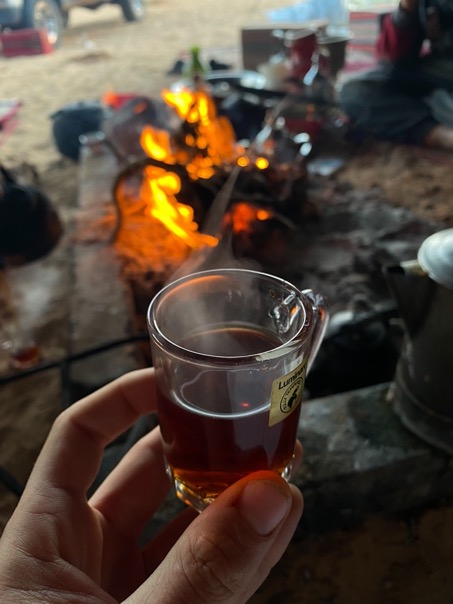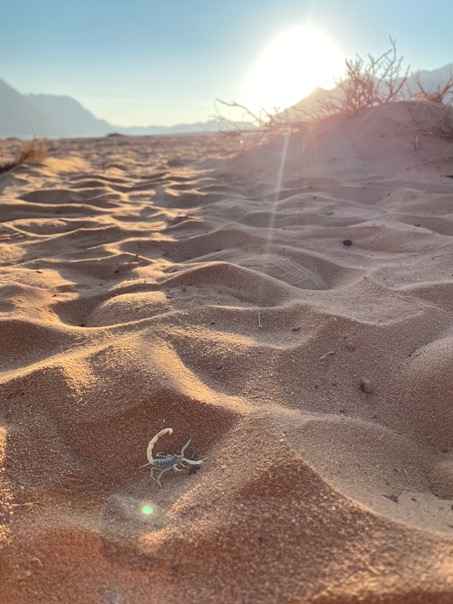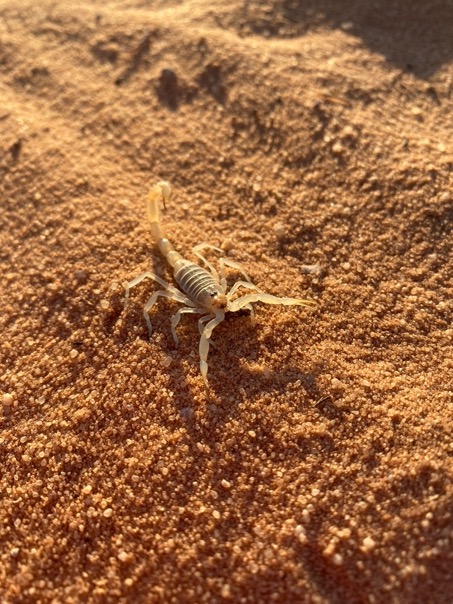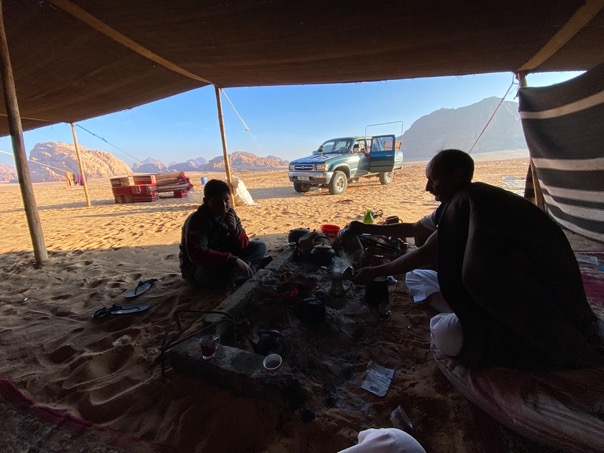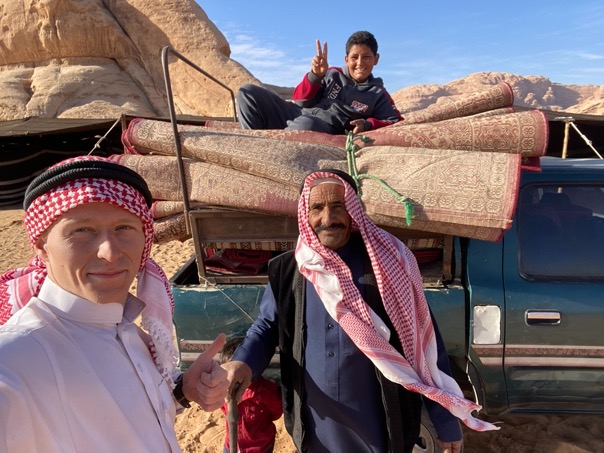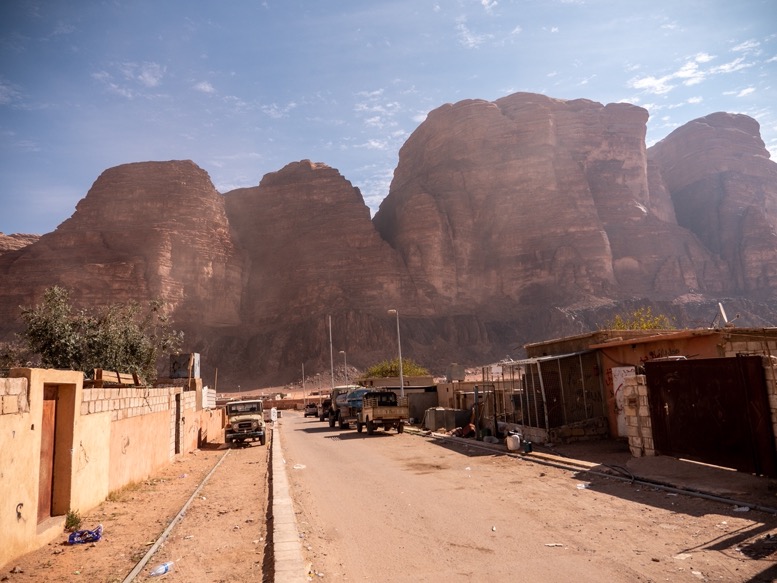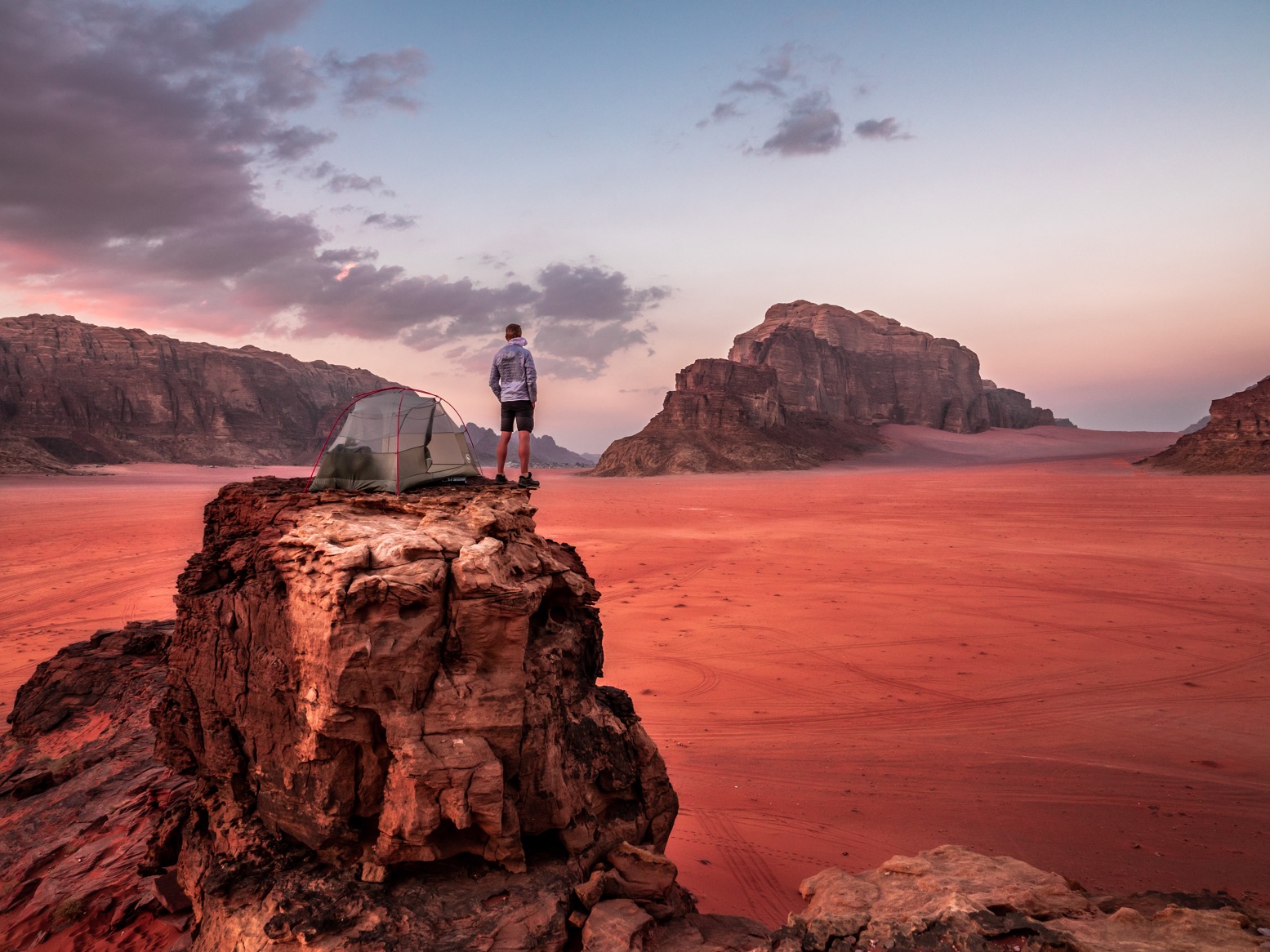
Wadi Rum
November 2022
\\ November 12 | Day 0: Arrival in Wadi Rum
So here I was, in the Wadi Rum Desert in Jordan. This hike started as a wild idea when I saw the making of Dune, which was, among other popular movies like Star Wars and the Martian, shot in this desert. The red sand, flat valleys and mountains that abruptly arise from the sand make this area look like Mars. So I started planning this desert hike, which was hard, since I've only found one other person who recorded a multi-day hike in this desert. There is no water in the desert, and apart from the tourist Bedouin camps, there isn't much out there at all. It would be a challenging hike, but also one of the most cinematic and unique ones I have done. And those are exactly the things I am looking for in a hike.
Wadi Rum stands for valley / dry riverbed of (fine) sand, and is called Valley of the Moon by locals. It has a rich history of camel trading caravans trekking through these valleys, and of the bedouins who lived and still live in this valley to date. Excavations in the region have revealed settlements thousands of years old, all people attracted by the several fresh water springs in the area.
I arrived in Aqaba, Jordan early in the morning, got my rental car and groceries, and set off for the hour drive to Wadi Rum. Halfway through I stopped at a pull out parking lot to eat something. When I was about to finish, some hundred meters away a truck pulled up for a break too. When I was about to leave he beckoned me over. A little hesitant I walked over to the side of his truck, where he had opened a hatch and created a small kitchen. He welcomed me and asked me to join for tea. I sat down on his old foldable stool as he poured me a sweet black tea with condensed milk. He spoke a little English and told me he was a Jordanian truck driver (I guessed him well above 60) who had driven supplies to Iraq for the Americans years ago, and so learned a little English. His pots and pans, stove and cutlery were old, suggesting he has been a driver for many many years. His big smile, marked face and bare feet gave him a lovable character. After tea, he then offered me lunch. Although I had just finished my lunch I didn't refuse this hospitable invitation and enjoyed flat bread he roasted above his stove with hummus and yogurt. I was so surprised by the kindness of this man, something you don't see in Western countries. To finish it off, he made me a Turkish coffee in his only glass and insisted I take it with me on the road, so I have coffee on the go. I took this glass with me back home. A reminder of this man's (and culture's) hospitality, something I can learn from.
I arrived in Wadi Rum Village around noon. Wadi Rum Village is the main gateway into the desert as well as the end of the road. From here the Bedouins drive tourists in their 4x4s and camels into the desert to their desert camps and for desert tours. It's a busy small village with little structure for a Westerner like me. Don't be afraid to come here without any reservations as you are offered dozens of accommodations by the bedouins before you even set foot in the red desert sand. I hadn't booked anything in advance, not knowing how quickly I would be able to get to Wadi Rum, but once there I quickly booked something at Quiet Desert Camp. I packed my hiking backpacking so I'd be ready to start tomorrow and was driven to the camp by Mohammed, son of Saleem, owner of the camp. The asphalt roads of the village transitions very suddenly to red sand at the edge of town. From there it is free for all, drive wherever you want. And they sure do. Being here at the start of winter, the temperatures are a lot lower than in summer (20-25ºC with sun), and thus it's the start of peak season. I bet at any moment during the day you can see several 4x4s driving in any direction you look in this area, it's crazy how many there are out there, and how many camps there are in this popular part of the desert.
Quiet Desert Camp is located at the edge of the main valley, right underneath a 400 meter vertical wall of the Khazali massif overlooking the big valley with the famous Nasrani peaks on the other side. This camp, like all the other tourist camps, are way more luxurious than the camps of the actual Bedouins, and have some form of running water, traditional tents but with floors and proper beds, electricity from solar power and toilets. There are several more luxurious camps as well in the desert, with Martian domes, AC, private showers, etc, but for those camps you pay 100 times more (yes, literally) than what you do in most camps like these.
At camp it was quiet, as all the guests were out for desert tours. I arranged with Saleem and Mohammed to have a 4x4 take me deeper into the desert to the far end of my loop to stash bottles of water. Quite a scenic 40-minute drive which gave me a good impression of what lay ahead of me.
The camp has its own cook (Salaah), who cooks food in a traditional Bedouin way. A fire is created in a hole in the ground (these days in a metal container). The raw meat is loaded onto a multilevel rack with the vegetables below it. The rack is lowered into the hole and then covered up by a lid and sand. The fire dies out, but the heat cooks the meat in a few hours. This was served at night with other vegetables, homemade hummus and much more. Really good food!
After dinner, people join around the fire for some tea and traditional music. Great experience, but way too touristy for me to film anything. I mentioned it in a conversation I had with Saleem, and he said he would arrange something for when I got back from my hike ...
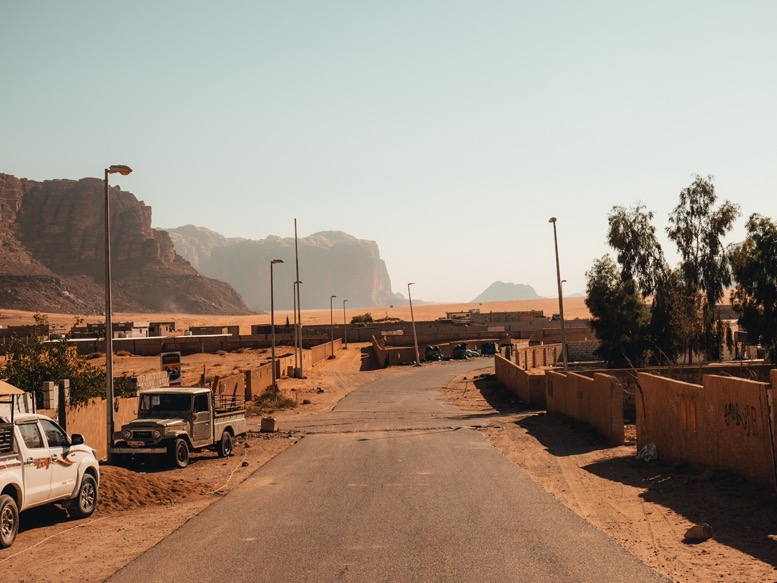
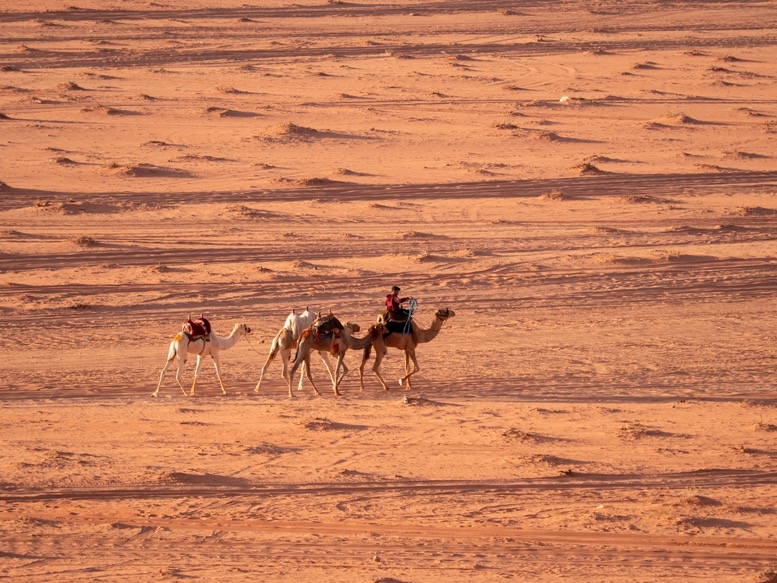
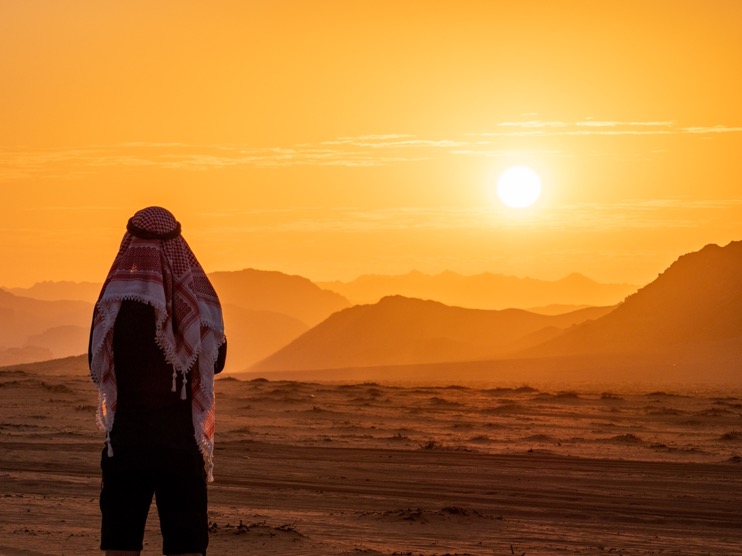

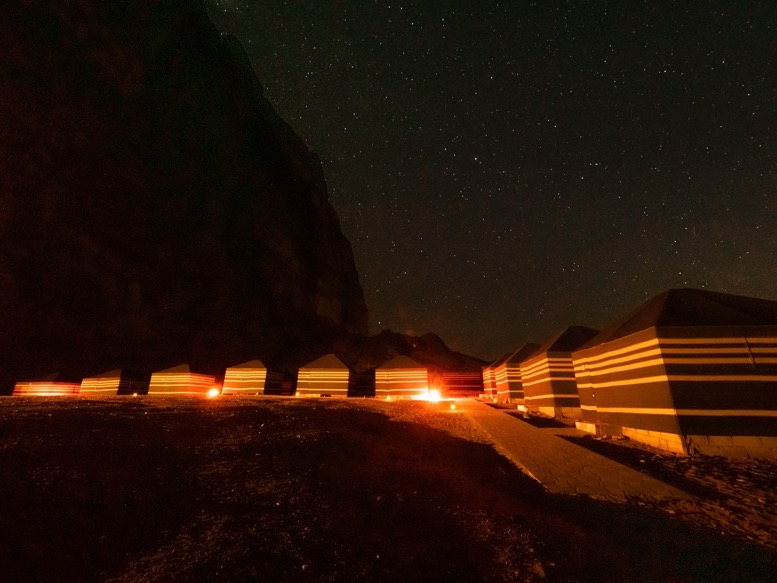
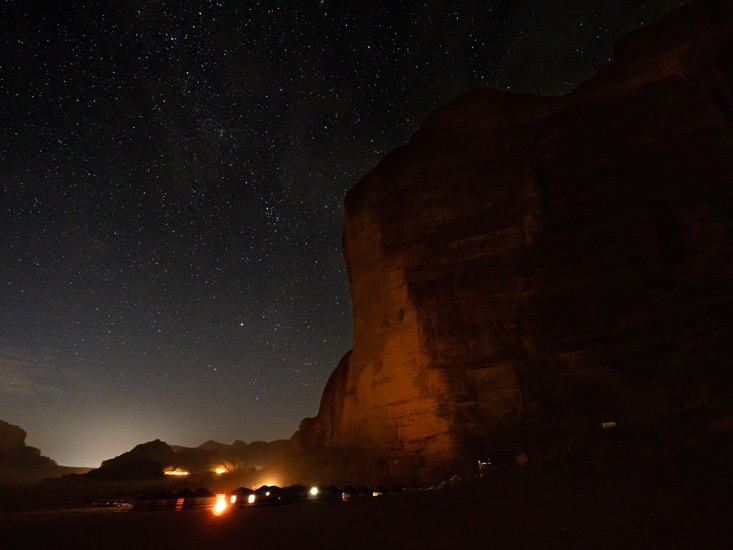
\\ November 13 | Day 1: The Red Sand Dunes
17.6km | 10.9mi
800m | 2700ft 600m | 2000ft (I highly doubt the elevation data from my GPS watch)
The next morning, after breakfast I got dropped off at my car again in the village, packed some last items and set out for my hike. My pack was heavy; with 8 liters of water in it. I stayed close to the cliffs as I left the village behind me. I passed by camel carcasses and skeletons, as well as piles of garbage. Clearly a garbage area of the village. But the further I got away from the village, the cleaner and quieter it got. As soon as I passed around the Nasrani massif I lost cell phone reception, and the landscapes started to get more interesting. The loop I had planned would take me along some of the most famous landmarks in the area, as well as some of the more remote and quiet parts.
Up first were the red sand dunes. Although most of the valleys are flat, the north-east side of most of the mountains have giant red sand dunes behind them. I presume the area has a common south western wind. The red sand dunes area is an area full of red sand dunes, all sort of interconnected. Quite a beautiful area, but also quite hard to get through with 29 kilos on your back.
After the dunes I crossed the valley to check out the Anfaishiyya inscriptions. These inscriptions of camels, people, children and tools are some 2000 years old and inscribed by trading caravans, depicting their movement through the desert. Impressive to see, and even more so because there are no fences and no trails, making it almost seem like they were only recently discovered.
For camping I had set my eyes on the largest dune in the area. It's a steep >45º climb to the top, and with well over 30% of my body weight on my back, the two steps up one step down reality wasn't easy. But up top the effort was well rewarded by an amazing campsite and great views. I pulled off my shoes, which by now were full of sand, and bathed my feet in the fine warm red sand. I pitched only my inner tent and didn't even bother to put the groundsheet. Staking the tent would have been problematic, but with little to no wind I wasn't too worried about being blown off the dune.
As the sun set, I hydrated my meal and watched the Mars-like landscape around me getting more red with the decreasing light.

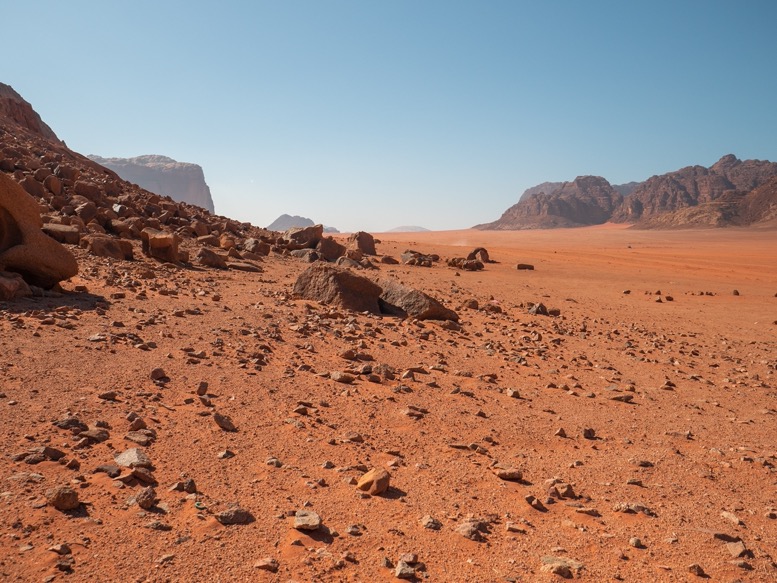

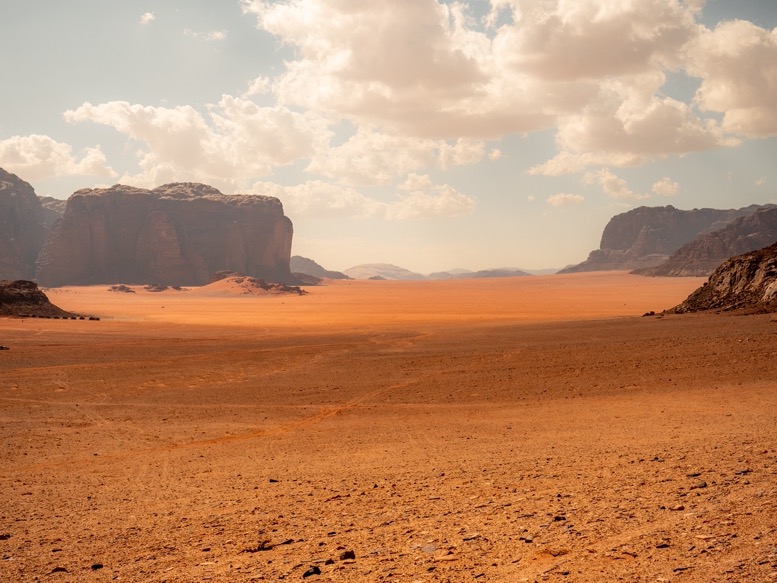
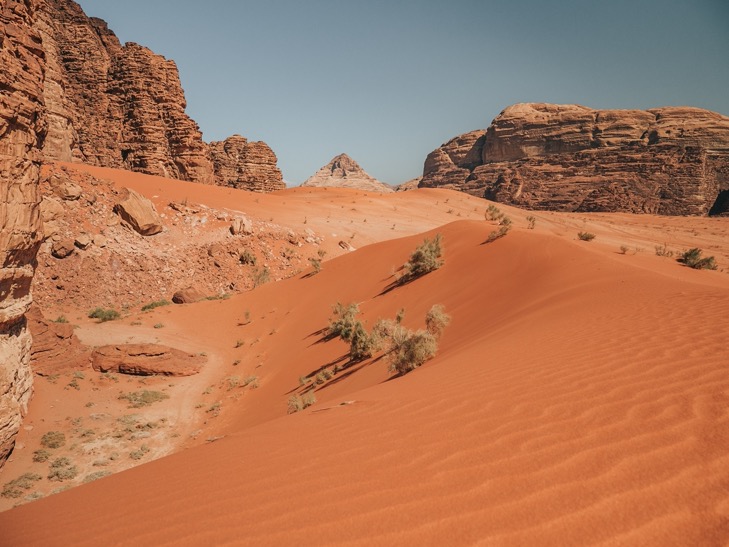
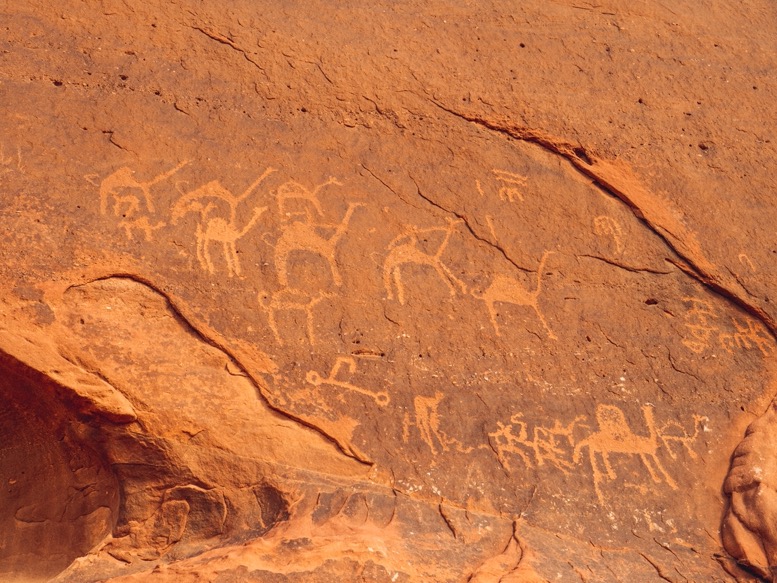
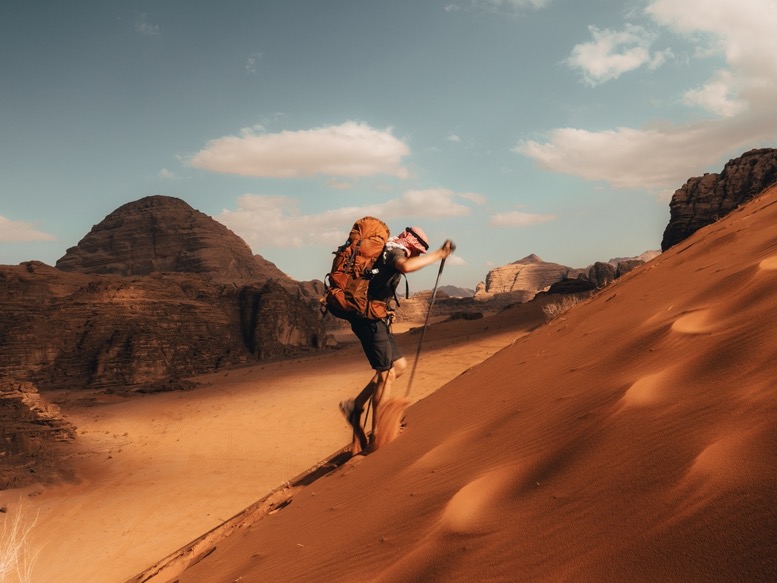

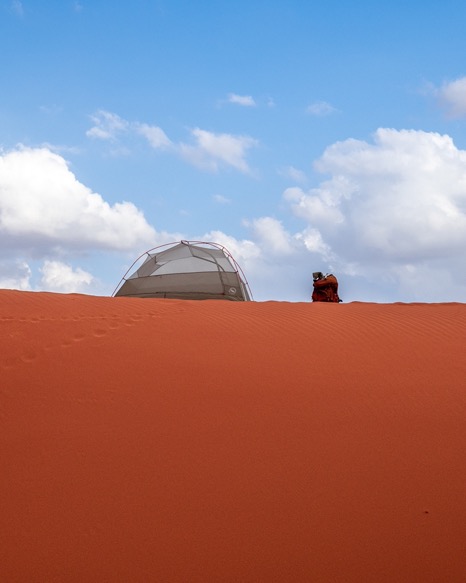

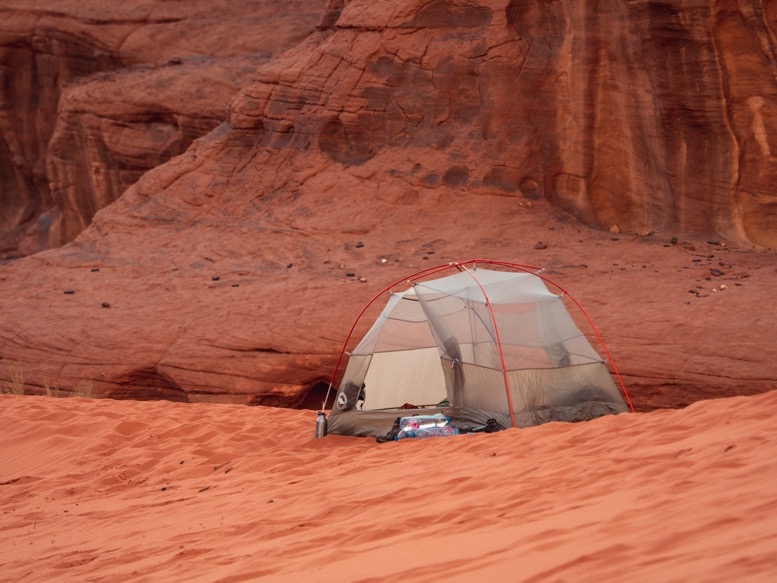

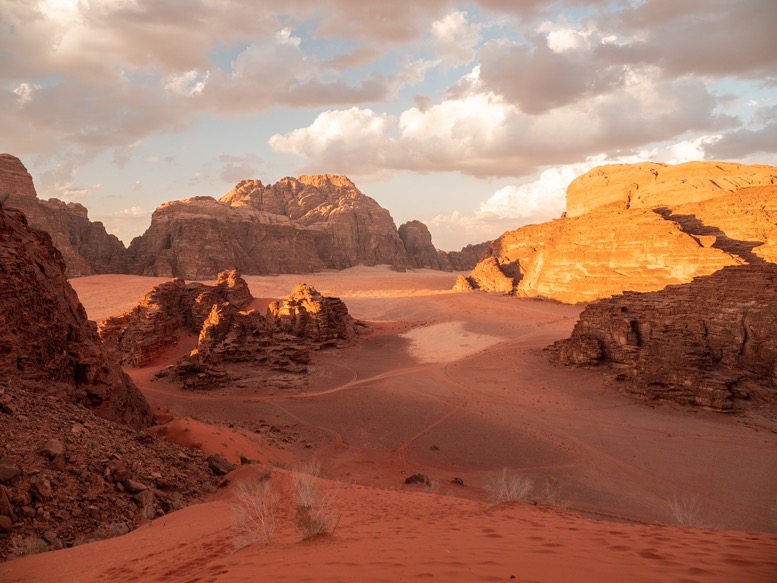
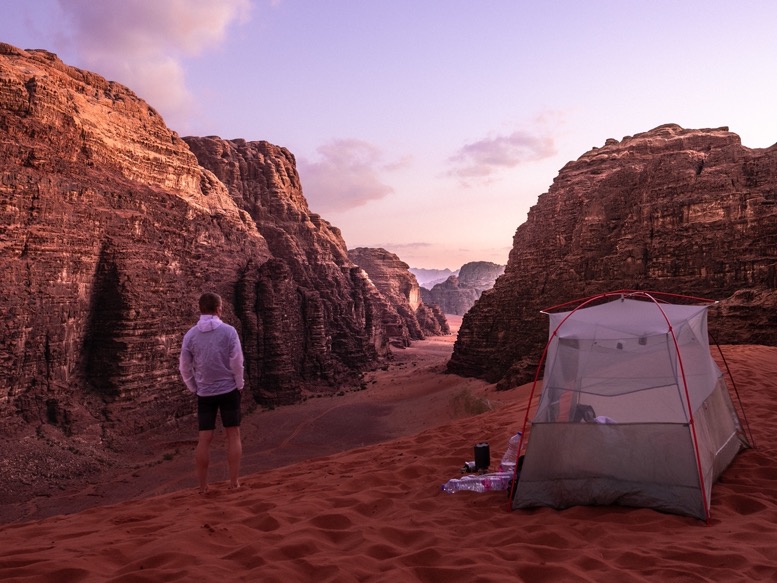
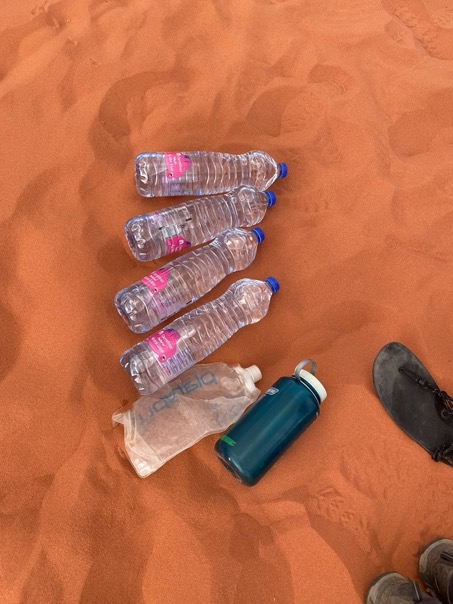
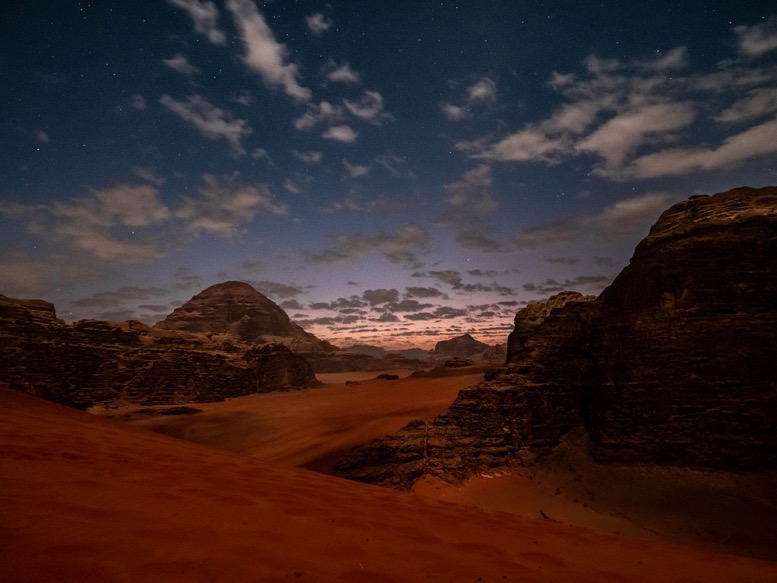
\\ November 14 | Day 2: The White Desert
25.4km | 15.8mi
1100m | 3600ft 1000m | 3300ft (I highly doubt the elevation data from my GPS watch)
They say nights are cold in the desert. Compared to the day that's true, but it's also not that cold. And with my new quilt, it was more than warm enough at night. Without any wind at night there was a lot of condensation though. I thought it was just from my breath, but as I walked around in the morning I noticed the sand was wet everywhere; I did not expect that in the desert.
I enjoyed the calm cool morning and set out in the hot sun. I got off the dune, and headed south. I passed over more sand dunes, some with beautiful untouched wind patterns, others full of tire tracks. It's hard to describe walking in a landscape like this. On one hand it's very monotonous: there is little to no vegetation and there is red/orange sand everywhere. On the other hand, it's a gorgeous landscape with a lot of surprises. The wide flat valleys reveal themselves one by one as you walk through the maze between the vertical rock formations that seem to grow abruptly out of the sand. The sand being moved around by the wind forms beautiful patterns, while the distant views between the mountains become hazier with the rising sun. The vegetation that is there looks toughened and slowly grown by the harsh conditions, but somehow still manages to grow by the little moisture it gets. There is not much wildlife in the desert. The scorpions and snakes are hidden away in the sand and in the shadows of the rocks. There are birds however, the only living things that break the endless silence. With their action radius, they manage to find water far away while they nest on the rocks, away from any predators.
Apart from the sections with sand dunes, walking in this desert is actually quite easy. There is little elevation gain, and most of the time, the terrain is pretty solid. I was making good mileage as I crossed one of the big valleys towards the first real sighting: mushroom rock. This 10 meter tall rock formation has a small base, and a wider top, somewhat representing a mushroom. It's a cool sighting, but also a popular tourist destination and thus packed with 4x4s and their tourists. I took a few quick photos, and quickly moved on, away from the people, and found myself in solitude again not much later.
With the sun now at the highest point and a tail wind, it was getting hot. I climbed up to a little plateau and sat in the sand for a bit enjoying a coffee.
Just before noon, I crossed the long valley and got to the Abu Khashaba Canyon. The kilometer long canyon is only about two meters wide at the narrowest point. It is a beautiful place with several big green trees, and a lot of vegetation. The little rain that falls yearly is collected in this valley and a lot less evaporates here in the shade. As I got out on the other side, I noticed how the color of the desert had changed. From dark red in the morning, to orange in the afternoon, to the now white color. The change is so gradual that I hadn't really paid attention to it so far, but now I suddenly noticed. This part of the desert is also way more remote, and thus the vegetation is pretty much untouched, The almost regularly spaced shrubs made the distant views look even more mysterious.
It was also here, when suddenly 4 camels walked around the corner. 4 totally different camels in size and color, slowly strolling along the horizon some 300 meters away. Unlike most camels I had seen so far, these were unattended and didn't have any head halter. But I bet these belonged to someone.
I winded and climbed through several more canyons in the white sand, passed one more wide valley and made it to my stashed water bottles. The 8 liters I started out with the day before were basically empty by now, only 30 hours later, so the timing could not have been better. I packed half of my stash in my backpack, and set out for the last part of the day. I had planned to camp high up on one of the mountains, close to the Burdah Rock Bridge, a natural stone bridge some 400 meters up in the mountains. There is some sort of a trail leading there, but it's hard to follow and the terrain is technical. By now I had been hiking almost 6 hours in hot dry weather, and with my pack again almost as heavy as I started with yesterday, it felt even harder. From far away these mountains look easy to climb, but up close I found myself in a maze of rocks. Unlike in the Dolomites a few weeks ago, these rocks are smooth, with very little to hold on to. That made the tricky section even more tricky with a heavy backpack: there isn't really a plan B. But ever so slowly I made my way up and down on my way up. It was about an hour before sunset I realized I might not make it to the top, and for the umpteenth time I lost the trail again. I walked back and forth, up and down several rocks, but I could not seem to find the right trial. What I did find however, was a beautiful campsite, overlooking the white desert with the red-orange desert in the distance. It was about 100-200 meters up from the ground on a steep cliff. There was a perfect flat spot for my tent, and something I also pay attention to: several good camera angles behind the tent to capture the moment. It didn't take long to convince myself that this was the right spot for tonight.
Sunset at first wasn't exactly what I hoped for. Just as I started the climb up an hour or so earlier clouds moved in. By the time I had pitched my tent it was almost completely clouded. A little disappointed (and spoiled probably, because believe me, the views were still amazing) I took some shots, and ate dinner. But as the sun was just about to dip below the horizon behind me, the cloud cover broke open close to where the sun was setting, illuminating the sky and consequently the whole landscape in this pink color. Just wow.

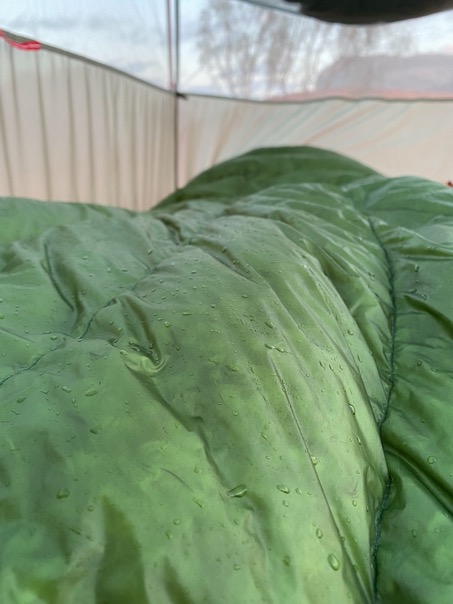


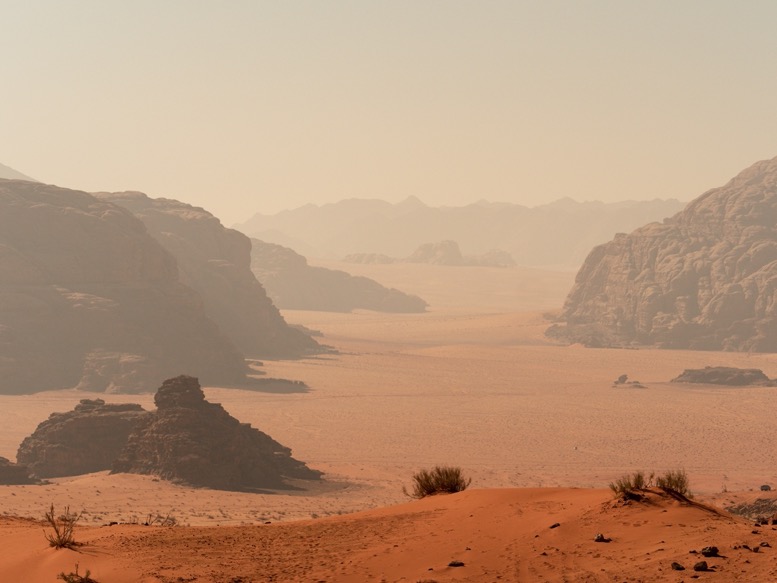

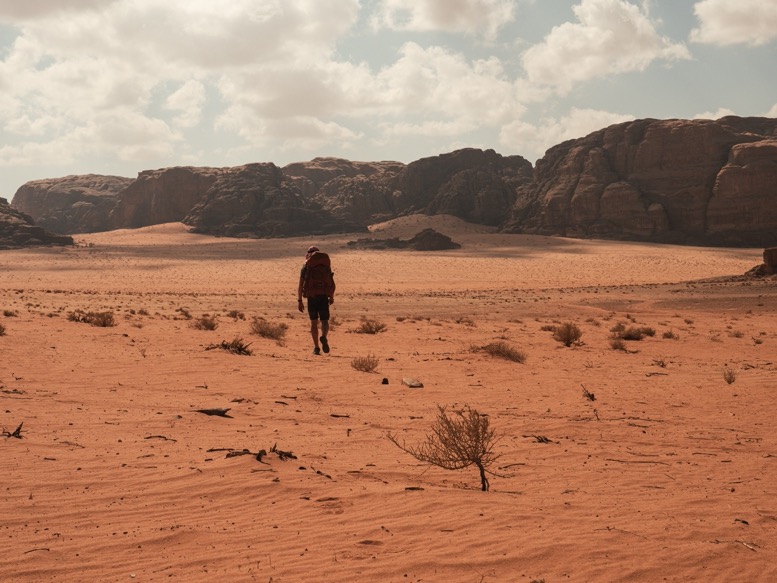

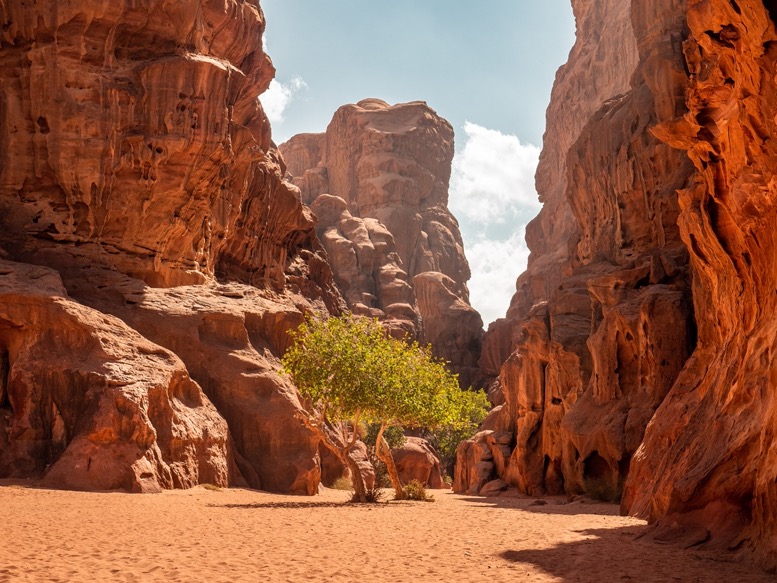

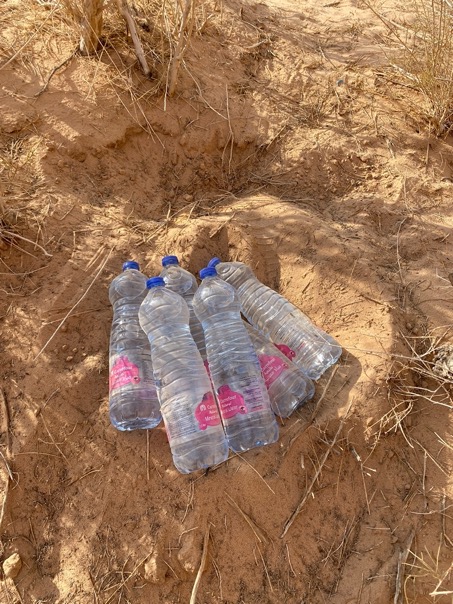
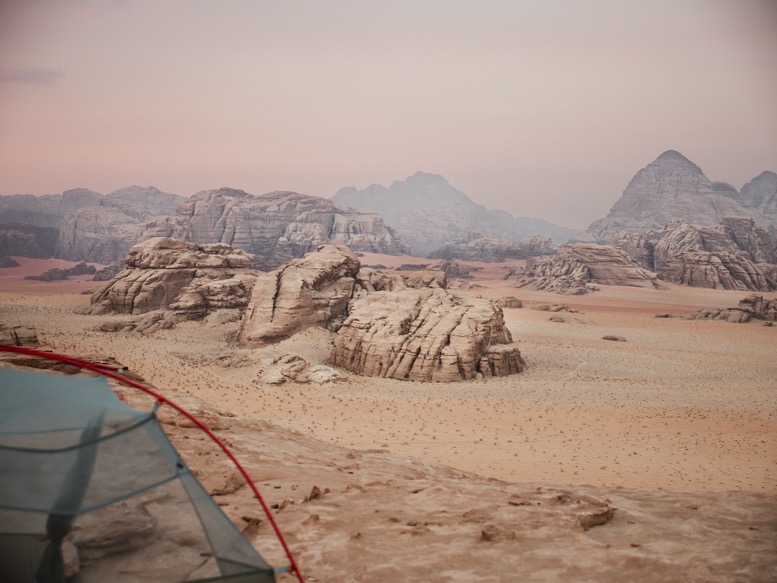
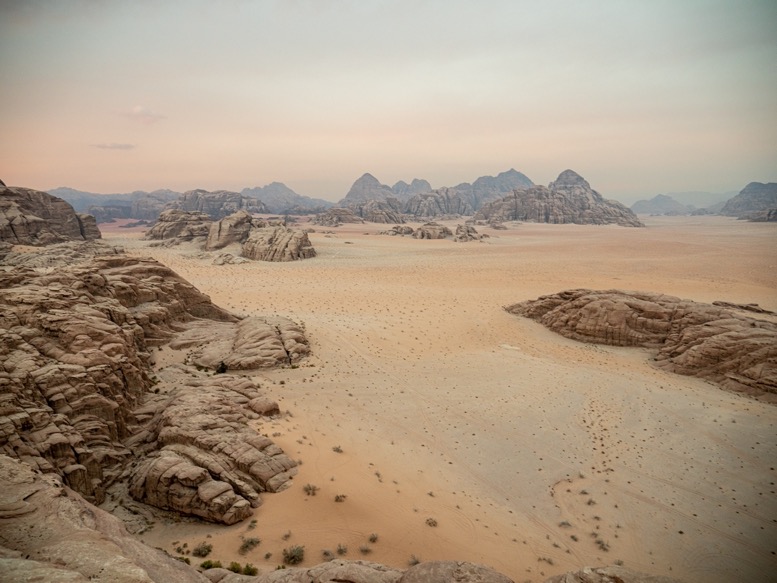
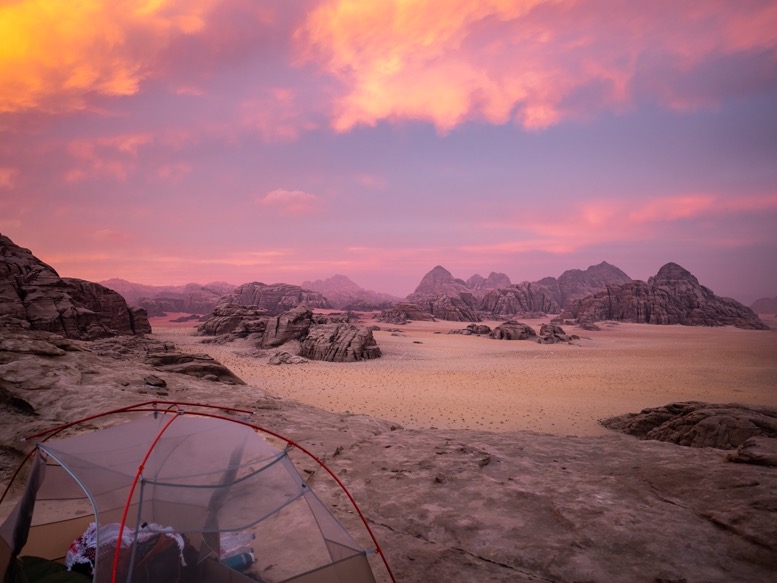
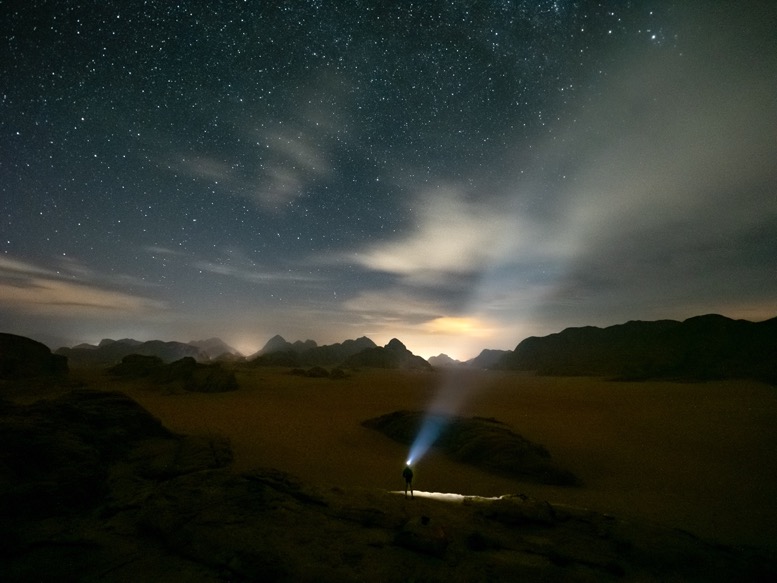
\\ November 15 | Day 3: Camping on Mars
22.6km | 14mi
700m | 2300ft 800m | 2800ft (I highly doubt the elevation data from my GPS watch)
The night was clear and with the sky full of stars. The morning started with low cloud coverage, and even some fog. Again so not what I expected to find in a desert, but for that reason beautiful. The clouds broke up an hour after sunset, but the haze didn't really disappear till noon. I climbed back down, got the remainder of my water stash and continued my way. I walked along the length of a white valley for several kilometers. On the ground the occasional camel and tire tracks. The tail wind, still coming from the northeast, didn't provide much cooling from the scorching sun, neither did the 5 new full bottles of water make it any easier. But I was enjoying the landscapes fully. There is a calming beauty to the desert that I love.
I arrived at Um Fourth, another natural bridge. This one was easier accessible, only being 20 meters above the ground. It was packed with tourists guided by their bedouins, but definitely worth the visit.
By now I had pulled off my shoes a few dozen times in the last few days to get rid of the sand. But for some reason it felt more and more that even after emptying my shoes, my shoes were still tight as if they were still full. As it turned out, that was actually true. Some real fine sand had crept through some of the seams on the inside of my shoes, collecting in what should be empty space between the hard sole and fabric inside. The only way to get rid of this sand was to make a cut in the fabric of both shoes. The simple trick did the job, and I got flashbacks back to the Tour Du Mont Blanc. These shoes needed to be replaced soon anyways.
I made my way back towards the red desert, winding through several canyons. I was getting tired. The days were long, the conditions were tough and by now my shoulders were painful and red by the weight of the pack. For the last night I had set my eyes on a rock formation in the middle of the famous red desert valley. The views from this rock 'island' are almost 360 degrees. For that reason it's also a very popular spot. I climbed up and looked around for a good campsite. Although there were several ok-ish spots, I didn't find that nice secluded spot I was looking for. I climbed down a bit to a harder to reach protrusion and there I found just what I was looking for. A small stone pillar with a flat plateau just wide enough to pitch my tent. Access wasn't easy as I had to climb up a 3 meter vertical wall. The spot was extremely windy, and with no loose stones or ground to stake my tent, I had to tie my ground sheet and tent to the rocks with lines. The views were amazing. I could look deep into the main valley to the east and see the spot where I crossed yesterday. To the north I could see Wadi Rum Village in the distance and the red sand dunes I crossed on day 1. To the south the Khazali Massif and the desert camp I stayed at the night before my hike. Everywhere around me the soil was deep red.
The sun set slowly behind the mountains in the west. Right after sunset, the red color appeared to be even more apparent; great pictures. The wind died down slowly, the stars came out, and the valley became quiet as the night fell.
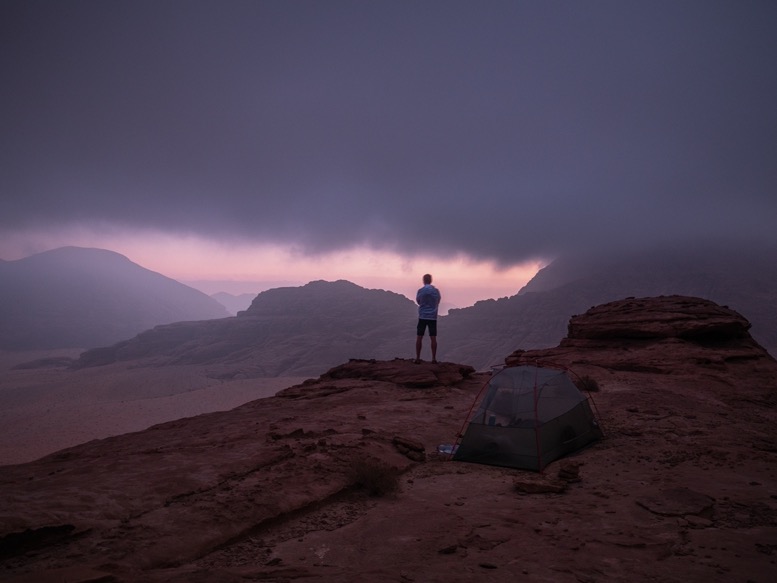
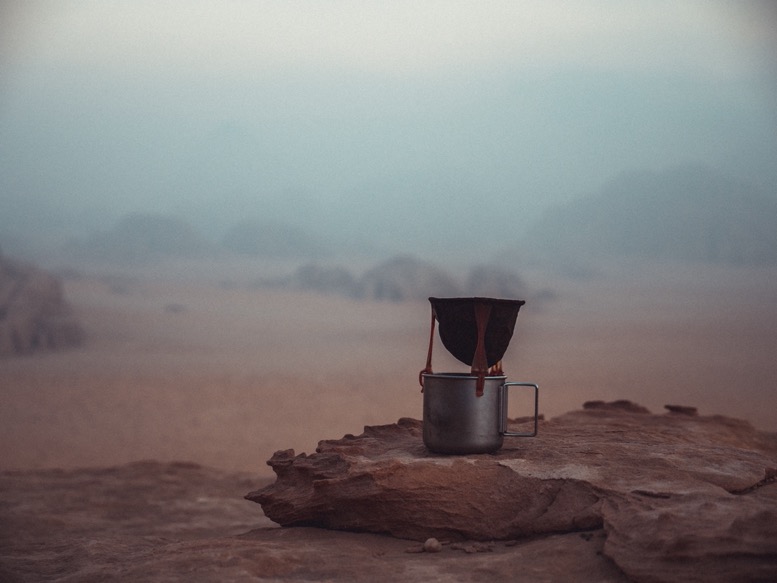
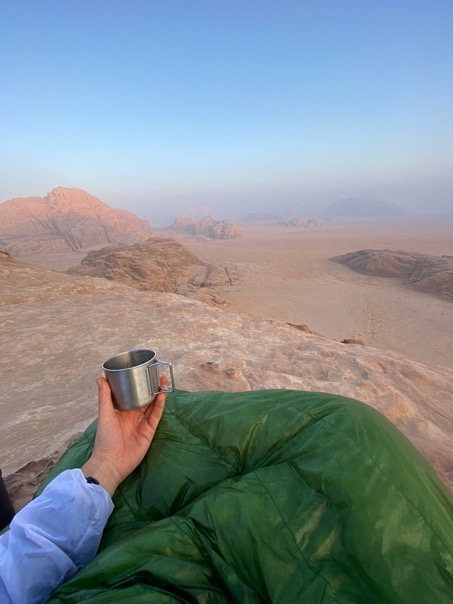
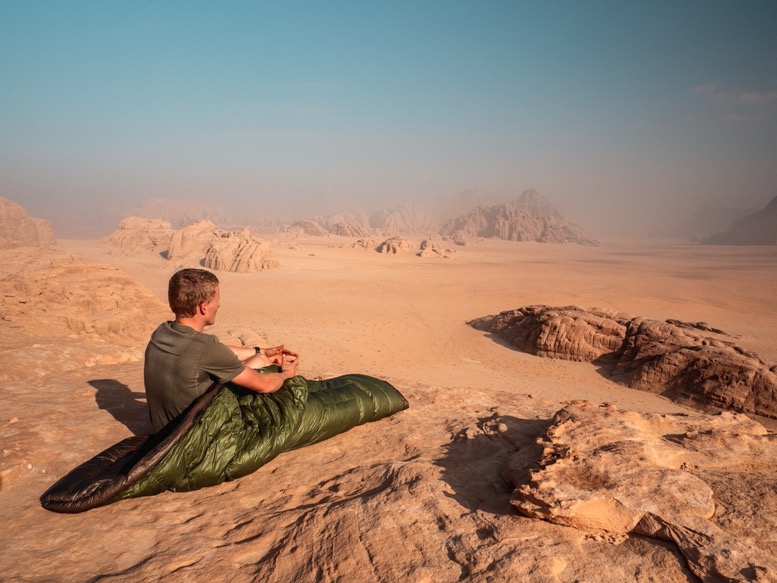


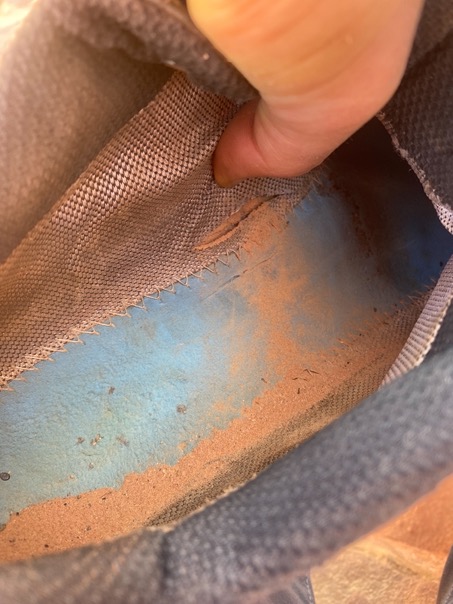
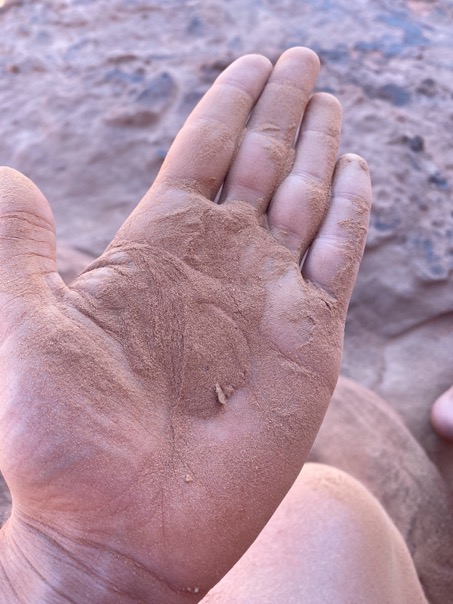
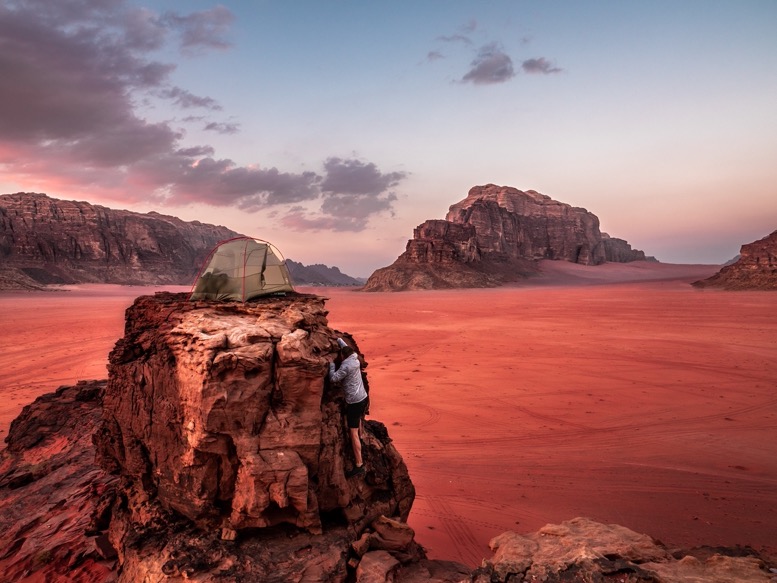
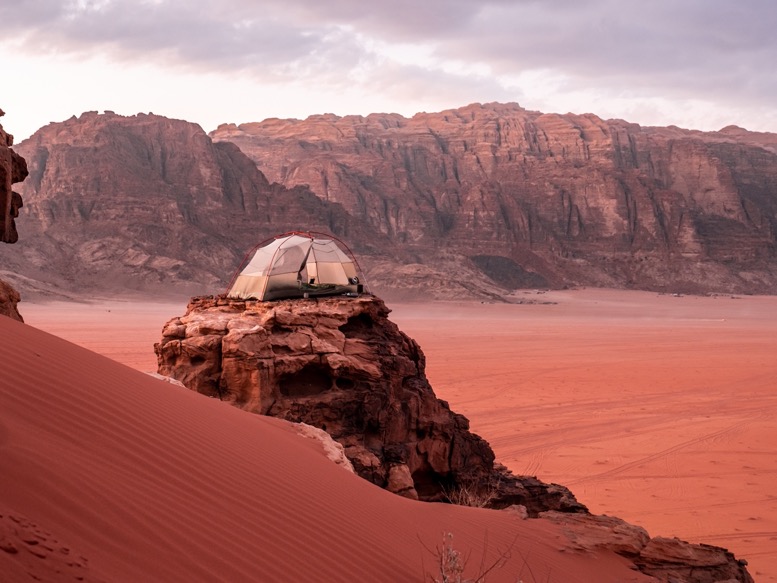
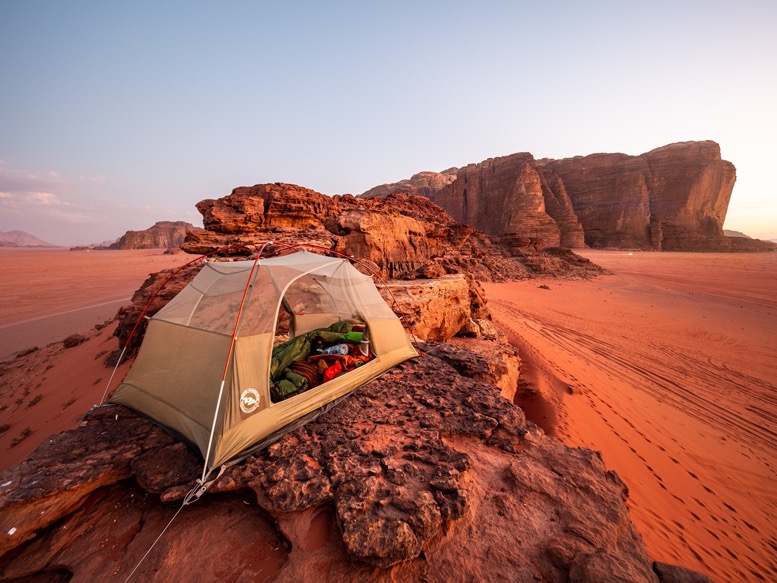
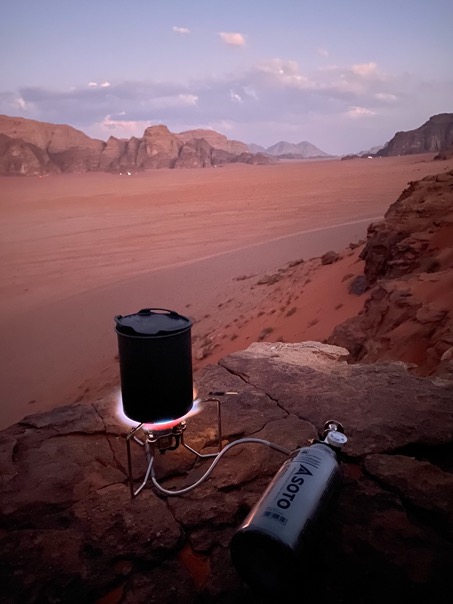
\\ November 16 | Day 4: To the Bedouins
7.8km | 4.8mi
100m | 300ft 100m | 500ft
The night was cold, and a bit windy; for the first time on this trip I wore my beanie at night. But nothing too crazy, and I hadn't even used my rainfly.
I woke up at 4:30, an hour before sunrise. I heard music down below. Still half asleep I set up right trying to gasp what was happening. I saw a car with the emergency lights on driving real slowly playing music, some people with flashlights. In the distance I saw a string of lights slowly moving in my directions. My first thought, still half asleep, was people were coming to the desert to party. Slowly waking up I realized that didn’t make any sense and that these were actually people running with headlines. It turned out that some sort of ultramarathon was taking place in the middle of the desert. The car with music was the leading car, followed by the first runner. Quite a sight to see to be honest, especially being right above the parkours.
I took my time in the morning noticing I was really tired after some intense days. It wasn't until 10am that I climbed down my rock tower for the last time (by now I climbed down and back up at least 20 times to get my shots). It took not more than half an hour to reach the desert camp from the first night. Saleem, the owner who had arranged something for the upcoming night, had told me to be there at 4pm. I put some batteries on the charger, looked the cook (the only person at the camp at the moment) friendly in the eyes for breakfast/lunch and relaxed for a while. In the afternoon I hiked over to the last sighting on my list: Khazali Canyon.
From a distance the narrow canyon looks like a natural entrance to a palace. The vertical walls on both sides are several hundreds of meters tall, while the canyon entrance is no more than 2 meters wide. This canyon was considered a holy place for centuries due to its natural tendency to collect water. At the entrance the walls are covered in inscriptions dating back up to thousands of years. The different types of Thamudic, Nabatean and Islamic inscriptions indicate people have been coming here for many eras. The oldest petroglyphs depict humans and animals, while the newer Islamic ones cite texts from the Quran in old Arabic. To me the most surprising thing was that there was nothing protecting these inscriptions. Every year thousands of people walk by these inscriptions, many of them unfortunately touching them. If this was the US or any western country for that matter, the whole canyon would be sealed off many years ago to preserve these.
The canyon itself is only accessible for about 100 meters without any climbing gear. But it's pretty impressive. Looking up I could only see a small stripe of blue sky. The upper parts of the canyon walls warm orange as they were illuminated by the sun. On the floor there were several smooth pools carved out by the flow of water over the years, still full over water. It's not hard to understand why this place was considered holy.
At around 5pm Saleem's son Mohamed picked me up at the desert camp to drive me to the Bedouins. They had arranged for me to stay with the Bedouins deep in the desert for 2 nights. And the timing could not have been more perfect he told me, as they were having a special engagement celebration tomorrow I could join. I was excited but nervous at the same time. I didn't know these people, their culture, their way of living or even their language. Now I was being driven into the desert to a place I didn't know. Totally out of my comfort zone. All I could do at this point was accept it and enjoy it as much as I could.
We drove deep into the white desert, and passed some of the sections I had walked by yesterday. About half an hour in I could see 2 black tents in the distance, pitched close to the rocks in the middle of a wide valley. These were unmistakably the heavy Bedouin tents made out of goat hair. We drove to one of the tents and walked to the opening. The opening was faced towards the rocks only a few meters away, offering perfect protection from the wind. The tent was divided in 2 sections: one third was open, with a small fireplace in the middle and carpets around it, a section exclusively for the men. The other 2 thirds were closed off and for the women. I was welcomed by Getter (probably not how you spell his name) a what I would guess 70-year old man in a traditional white thobe and white-red keffiyeh on his head. He was walking barefoot on the carpets, but quickly put on his sandals to welcome me. In his right hand he held a hiking pole because, as I later found out, he had some back problems.
He spoke a few words of English and invited me to come in and join him and 3 young sons/grandsons around the fire. Mohamed, who I later found out was a cousin of Getter, and I sat down. One of the younger boys, Rahed, took a porcelain cup from a small bucket, washed it, and took an elegant teapot from the fire. He poured me a small black tea with some sort of cardamon or something. This was the welcome tea, poured to everyone coming into the tent. I finished the cup and was explained to shake the cup when finished to indicate you don't want more welcome tea. After the welcome tea followed the real tea: extremely sweet black tea poured in a small glass. This is the tea that is most regularly drunk, and appears to be drunk even more than regular water.
Although the oldest two around the fire spoke a few limited words of English, they didn't seem to bother to do any translation of their conversations. It's probably just a cultural difference, and I honestly got used to it pretty quickly and accepted the fact. I was here to observe and in this way it seemed to be even more real.
I took a few shots with my camera, but didn't feel comfortable doing so often. In addition Saleem had given me 2 words of advice before I left: don't film or photograph women and don't tell you're doing stuff for YouTube, instead just say you're traveling.
I was wearing shorts, with a long sleeve shirt. Out of the wind and with a fire it was more than warm enough for me. For the bedouins it was cold. They were wearing at least 3 to 4 layers, as they are used to the hot 45 degree summers.
As the sun set, more men started to pour in. All sons of Getter who worked at the tourist camps all day. All were welcomed with welcome tea as they gathered around the fire. After sunset it was time to eat. One of the men went over to the women's side of the tent and came back with a big 50-centimeter plate of food, called a Mansaf (meaning large platter), that Getter insisted on putting right in front of me. It was a metal plate covered with flatbread, then rice and topped off with chicken. The rice had a juicy taste probably by the juice the meat was cooked in. Then everyone joined around the plate and started eating with their right hands. Asking if I wanted a spoon I of course denied, and tried to look as skilled at this technique of eating as if I'd been doing it my entire life. The food was excellent and really tasty. Eating doesn't seem to be as socializing of an event as I am used to. They eat fast, don't really talk and as soon as they're finished, they stand up to wash their hands and sit around the fire again. When everyone was finished, the plate of food, still half full, was brought back to the women's side I assumed for them to continue eating on.
After another round of tea, the sons of Getter drove off one by one, and it was time for bed. Without electricity the bedouins seem to really live by the rhythm of the sun: wake up at sunrise, go to bed at sunset.
As they pulled out their mattresses and blankets from the other room (Getter's wife was sleeping there too), I walked into the desert a bit to pitch my own tent and get a good night's sleep.
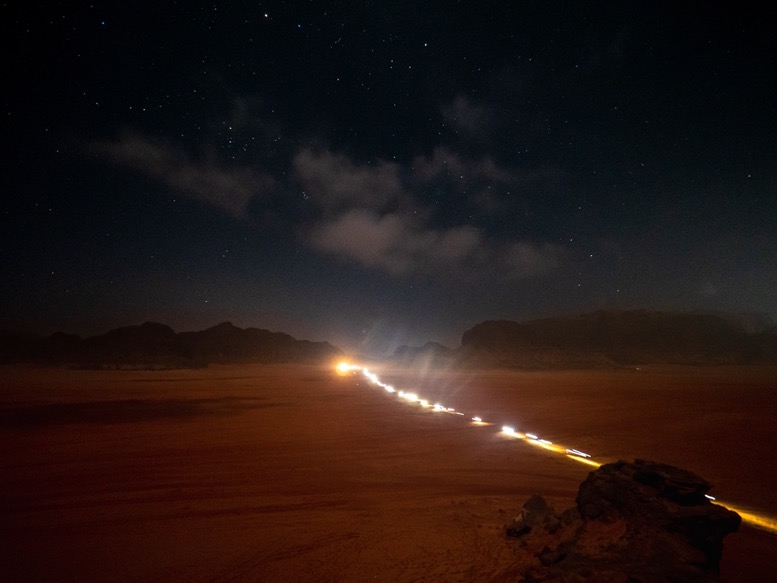
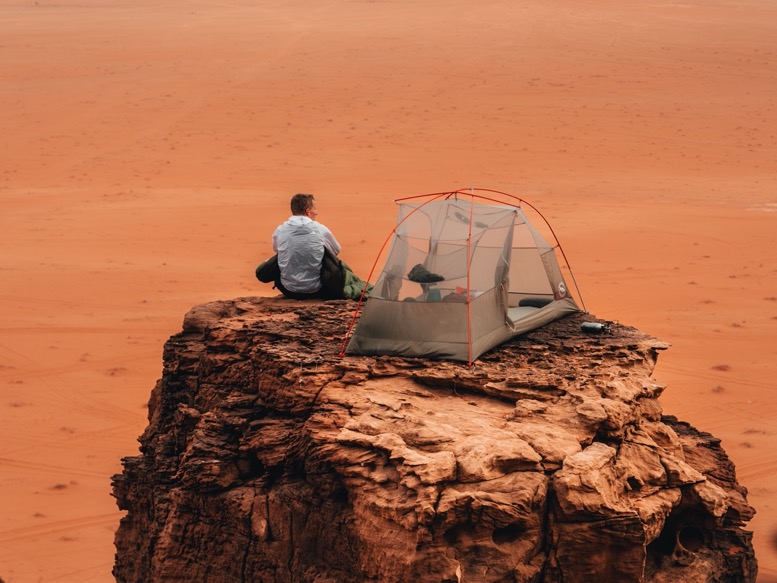
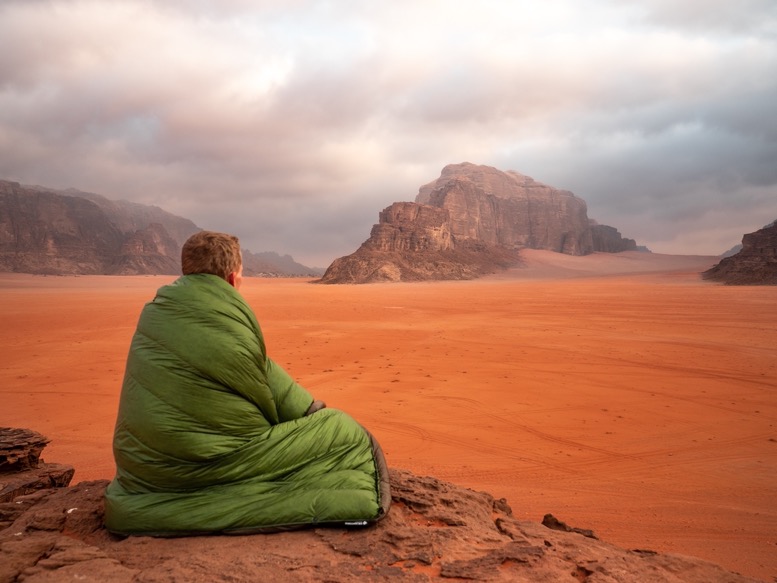
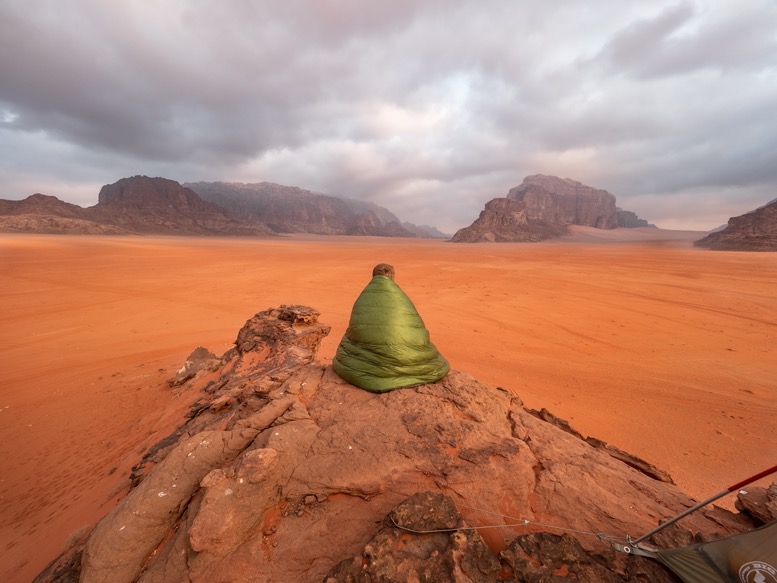


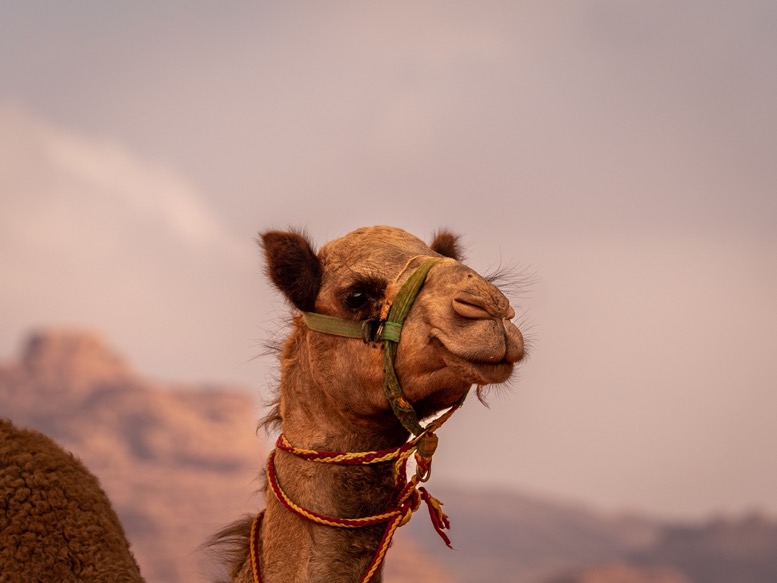

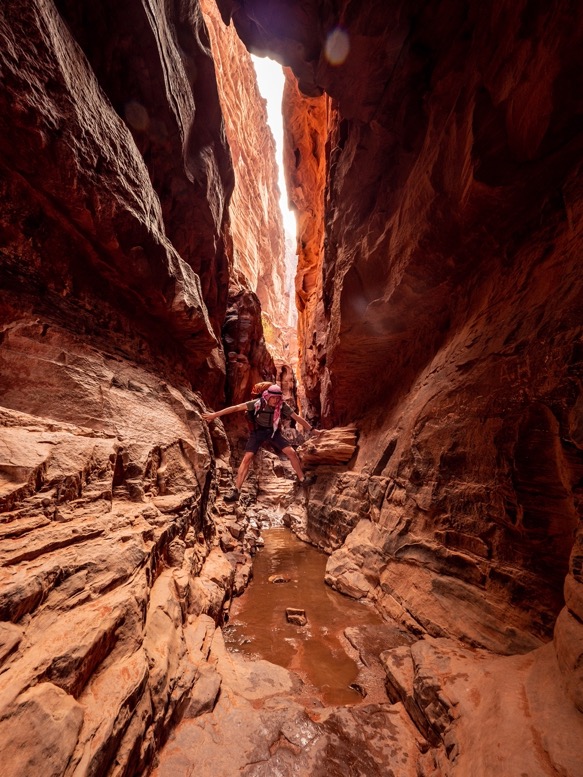
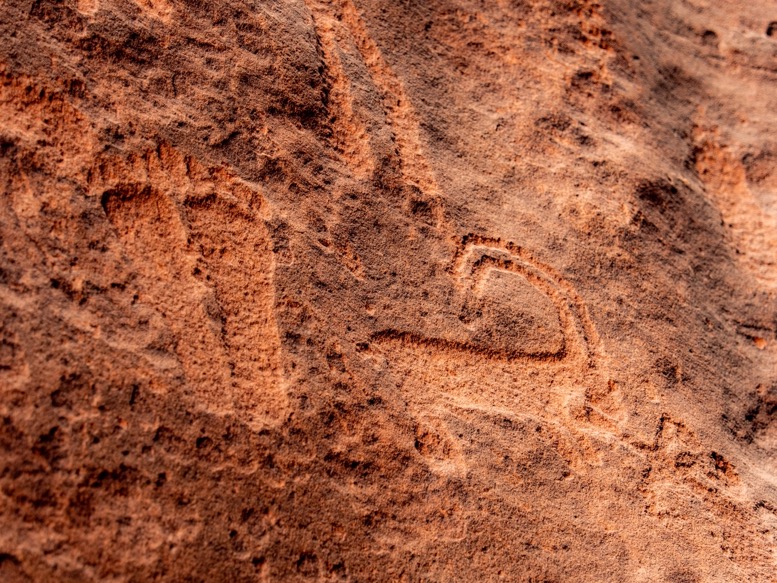
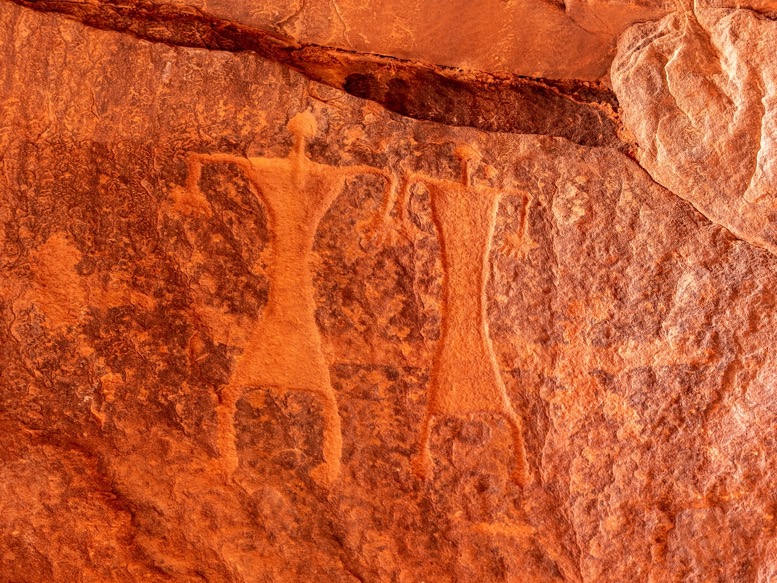
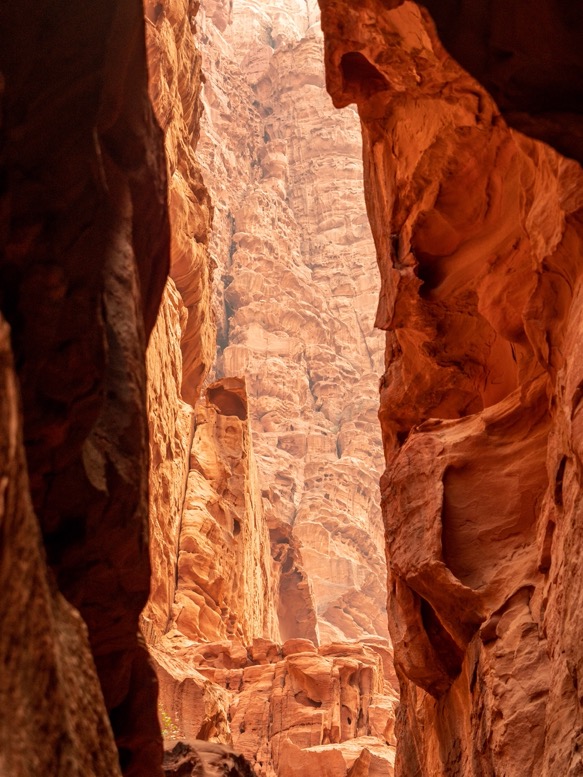
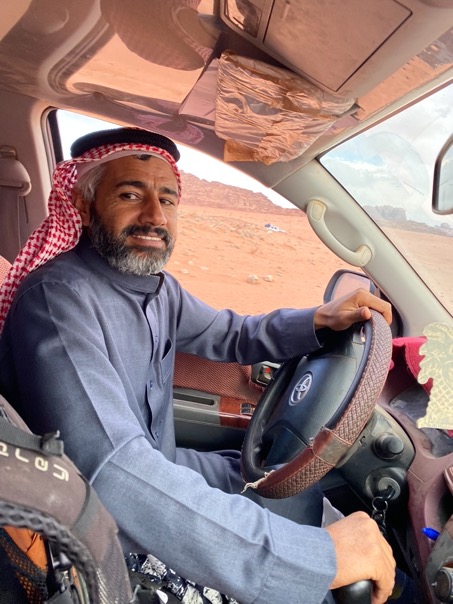
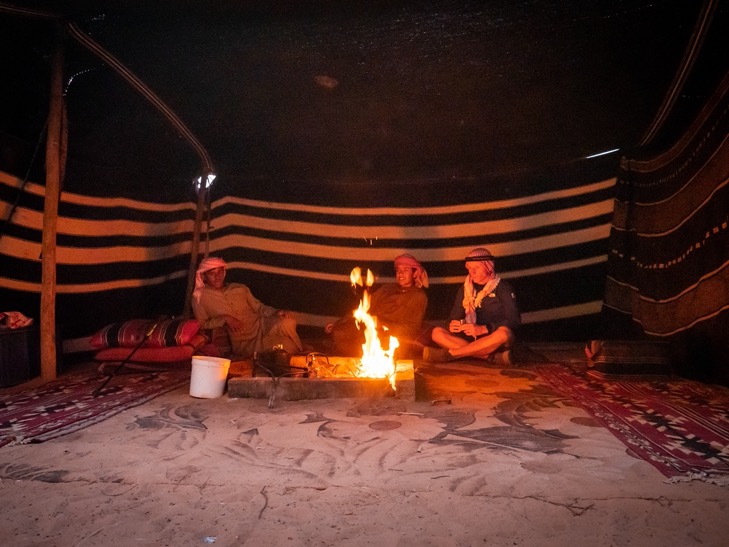
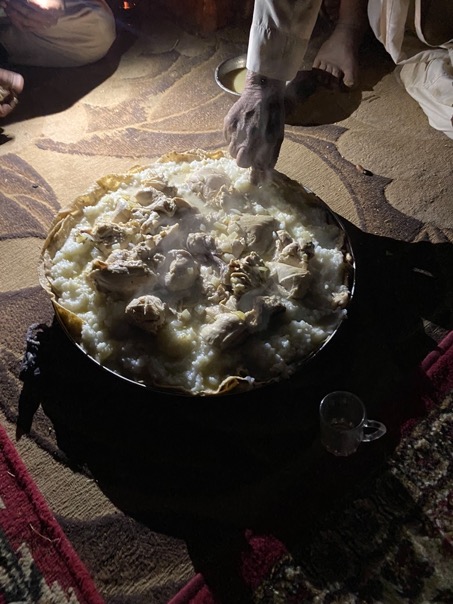
\\ November 17 | Day 5: Living the Bedouin-way
The next morning I realized once again how beautiful this place is. The morning light just before sunrise illuminated the white desert in a uniform way. The distant view of white sand and bushes contrasted against the steep mountains. A view I was still not bored of seeing.
At 7am I had packed my tent and was once again sitting with Getter, Mohamed and Rahed in the tent with tea. I got a gift from Getter: a white thobe. And it turned out to be the perfect size. I felt like I started to blend in more and more, with the looks then, because as one bedouin said to me: "you dressed like a bedouin, but you don't look like bedouin."
The engagement is a big thing for the bedouins, most of whom are muslims. At the time I knew very little what was going to happen. All I knew is there was going to be some sort of party, with a lot of people, with a big meal. That's it. For the meal 3 goats had to be slaughtered. We went over to the sheepfold and Getter selected 3 goats. Together with Mohamed and Rahed I helped get the goats, who obviously were way too keen on escaping, in the back of the old Toyota. Quite a fun but obviously chaotic situation. With the goats loaded, Getter, Rahed and I set out towards the village, while Mohamed returned back to the desert camp for a day's work. The drive took about 45 minutes or so, through some beautiful parts of the desert. The old Toyota Hilux bounced around on all the bumps, but looked to have been doing so for many many years. There were not many things about that car that could not have been broken: some mirrors were missing, the windshield was cracked everywhere, the paint burned off probably 10 years ago, and some of the doors would only open with a special manual. Every morning Getter idled the car for 20 minutes and checked the oil and coolant fluid (water) before using it. But then it ran like a charm, and probably will for some years to come.
We drove to the butcher in the village where we offloaded the goats. I witnessed the butcher cutting the throats, and then slaughtering them one by one. Having hunted before, it was not completely new for me, and these kinds of things never distress me. It took about an hour or two for the 3 goats to be cut into pieces and cleaned. In the meantime I went to grab a bite at a local store with Rahed. I guess Rahed is about 14 years old, but no matter how I tried to ask him or Gatter, I could not get an answer. Rahed is a young energetic fellow, about whom I know very little, but with whom I could laugh. He doesn't speak English apart from his classic question 'Good?' asking me if I was ok many times, and 'Good, good, very good' if I asked him that question. I don't know if he goes to school, but he seems to recognize and interact with some of the kids we ran into in town. He doesn't read or write, I found out when I tried to use Google Translate for some questions. He for sure helps around a lot at camp, and never seems to complain. He's the one that stands up and pours tea for guests most of the time, and the one that hauls around with a lot of stuff. If I would have had a chance to have a full conversation with someone at camp, it sure would have been him. What would his hobbies be, what are his dreams for the future?
With the goats chopped up in the back of the car, the (to me) chaotic grocery shopping began. Back towards camp we stopped at at least 10-20 places to get bread, yogurt, goat feed, water, suitcases, a couch and more. We then picked up two women and sitting in the bed of the Toyota between all the groceries, goat poop and partially crushed by the couch, we drove back to camp.
The celebration is separated for men and women. The tent I stayed in so far would be for the women, the one for the men a few hundred meters away. Not being used to this kind of division, it feels strange at first, but the more I observed, the more I noticed the men really take care of their women. The women had a fully closed off tent with a big stove in the middle, a small generator for lighting, and music, while the men only had an open tent with a small fire for tea.
At the men's tent we started on the preparations, after a cup of tea around the fire of course. The tent had to be slightly modified. About 10% of the 30 meter long tent was dedicated as a cooking area, while the other part was the gathering place. The tents, made of goat hair, are extremely heavy. The thick fabric doesn't look waterproof, but from what I've heard gets waterproof as the fibers expand when getting wet. The sheets looked old, but being so durable would probably last for decades.
In the tent we removed the last few shrubs from the sand. This indicated to me that this tent hadn't been here for that long and was probably set up specifically for this occasion. The bedouins are nomads thus travel around in the desert finding food for their goats. Most of the time I just followed the example of others, making myself quite useful. We rolled about 2 dozens of carpets along the perimeter of the tent for guests to sit on.
The pieces of goat were put in a large metal pan that was then filled up with water and fermented yogurt (jameed) and a lot of salt. It was put on a large stove and brought to a boil.
With the evening approaching, more people started to pour in. Each and every one of them went around the circle as everyone stood up to welcome him and was welcomed with a welcome tea. At its max there were probably about 80 men in the tent, and to this day I don't even know who the upcoming groom was.
Then another tradition for this type of celebration: shooting guns. Several men pulled big guns from their cars, and one by one started shooting in the air while the kids ran around picking up the empty shelves. I could only imagine being out there camping like 2 days before and suddenly hearing this hail of guns firing.
So the tribe I was around with was the Zalabia Wadi Rum tribe, one of the many bedouin tribes, or families. In this culture having a lot of children is normal. Saleem has 'only' 8 sons, while his brother has over 30. That makes it that basically the whole Wadi Rum Village and all the tourist camps in Wadi Rum are one family, the Zalabia family.
Sitting in the circle in the tent I got the question from someone what my name was: 'Harmen' I replied. It was here when Getter, who was sitting on the other side of the tent, joined the conversation, shouting something in the trend of 'your new name is Hadayah Zalabia'. Hadayah (pronounced Ataie) means 'gift' in Arabic.
The goat had now been cooking in the yogurt for several hours. The hygienic standards I am so used to in the west, didn't really seem to hold here. Everyone that walked by tasted a sip of the juice by using the same big spoon or cup. After sunset it was time for eating. About a dozen or so of metal plates were spread out on a plastic tarp and similar to the meal yesterday, the flatbread was spread out over the plates, covered with rice and topped off with the goat and the yogurt juice it had been boiling in. This is a traditional Jordanian dish called Mansaf. These plates were then brought into the main tent and spread out onto the sand in the middle. The men then gathered in small groups around the food to eat. Not everyone can eat at once, so people eat and make room for the next person to eat. Me being busy to capture this tradition the best I could wasn't in the first group to eat. Getter, noticing that was obviously very concerned his guest wasn't the first to eat, called me to come and made sure I got a spot around one of the plates. Such a hospitable guy. The food was soo good. The rice was juicy and tasted like goat. The meat was tender and strong in taste. I loved it.
Once everyone was satisfied and back on the carpets, the evening was closed off with a cup of tea. In contrast to the arrival, the leaving of people went mostly unnoticed. With a dozen or so men, including Rahed and Getter, I sat around the small fire a little longer, before heading off myself to pitch my tent. This must have been one, if not the best night I've ever slept in a tent. I was overwhelmed and overloaded by all the impressions. Perfect ingredients for a good night's sleep.
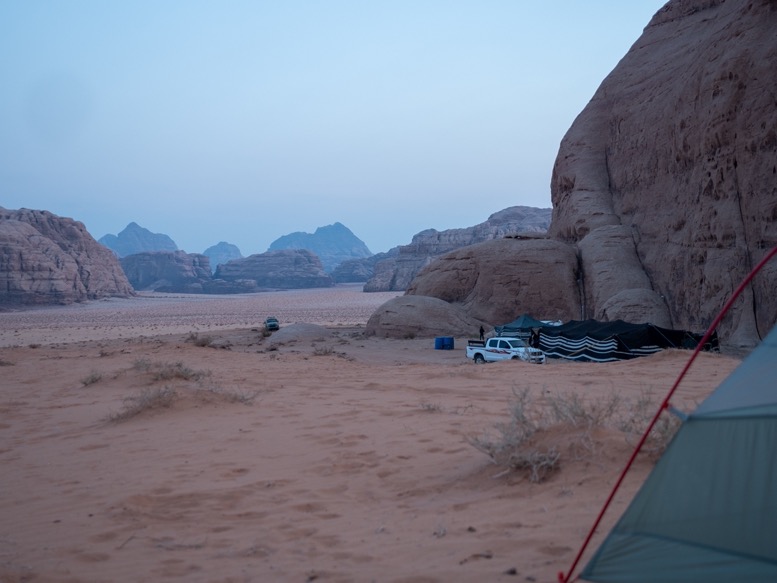
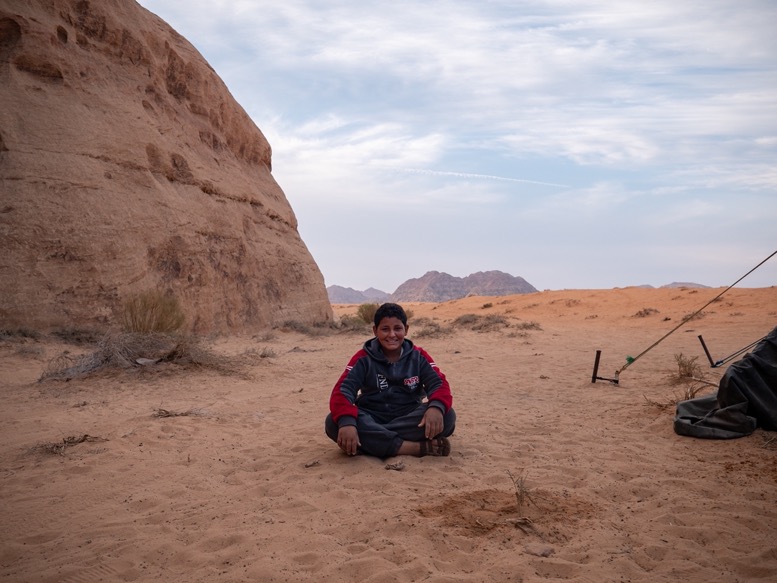
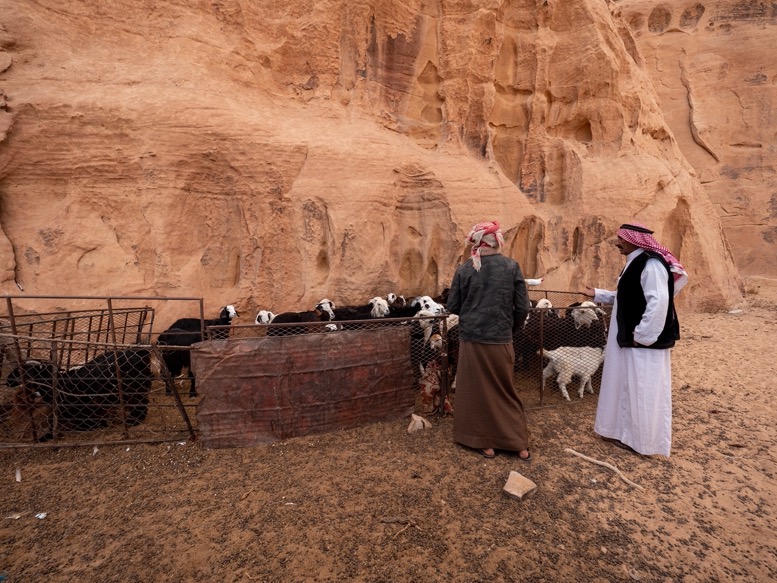
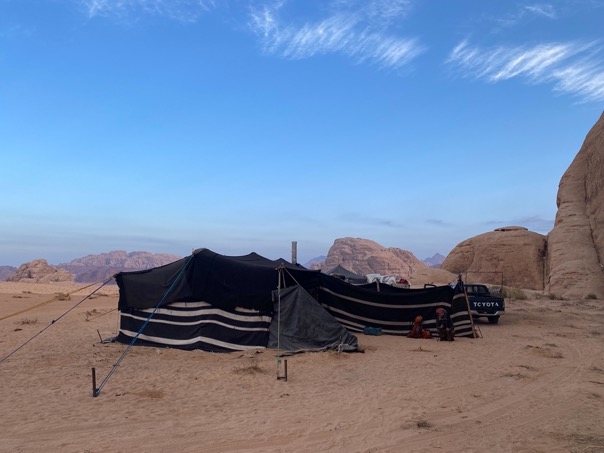


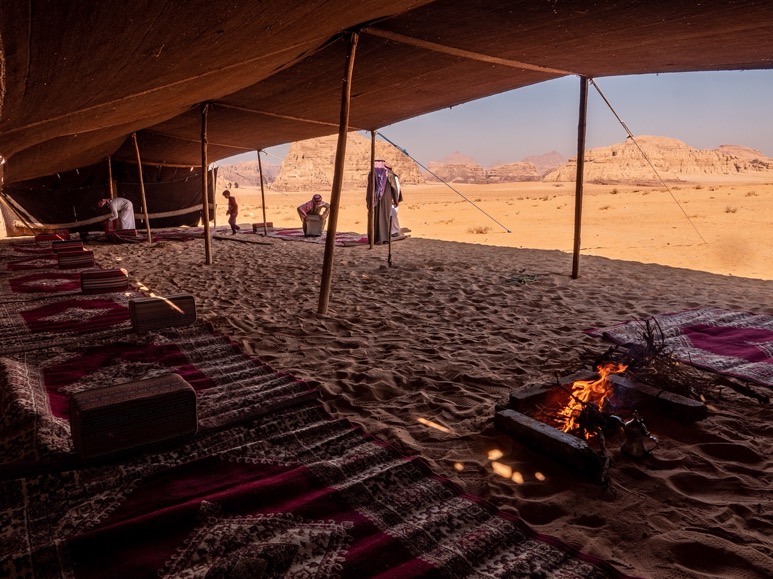
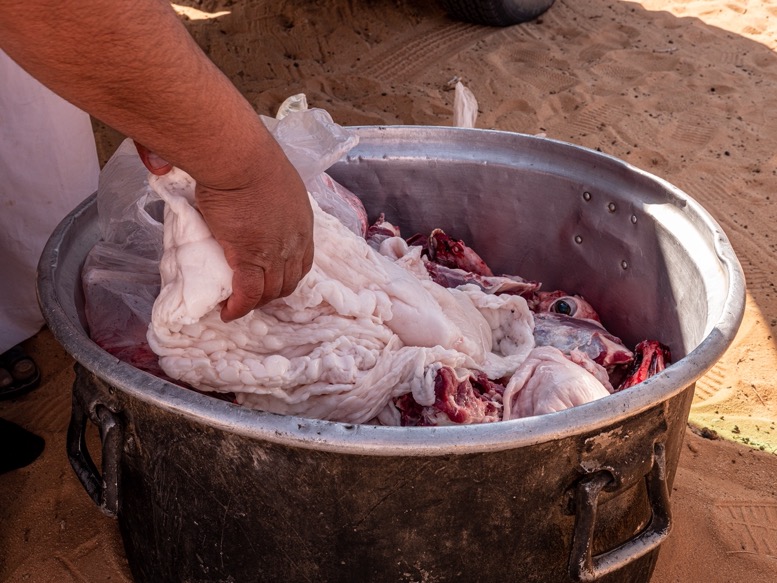

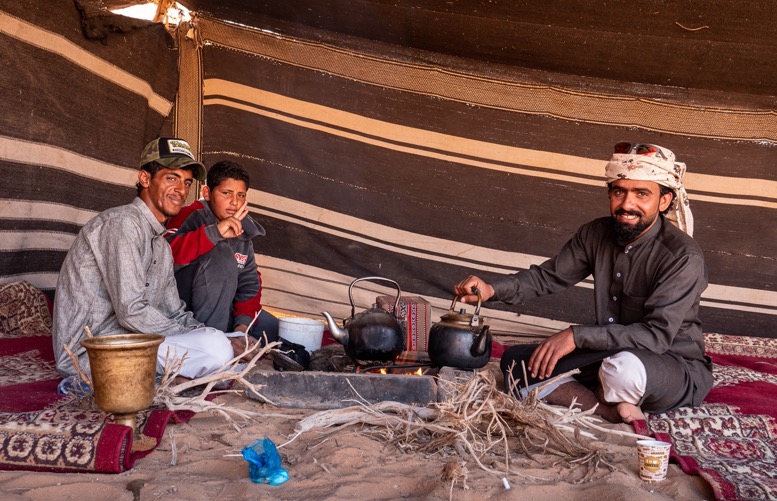

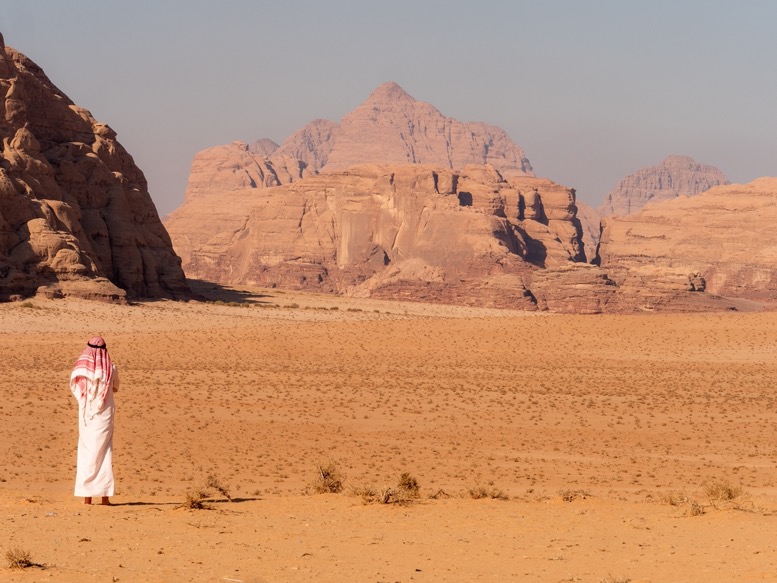

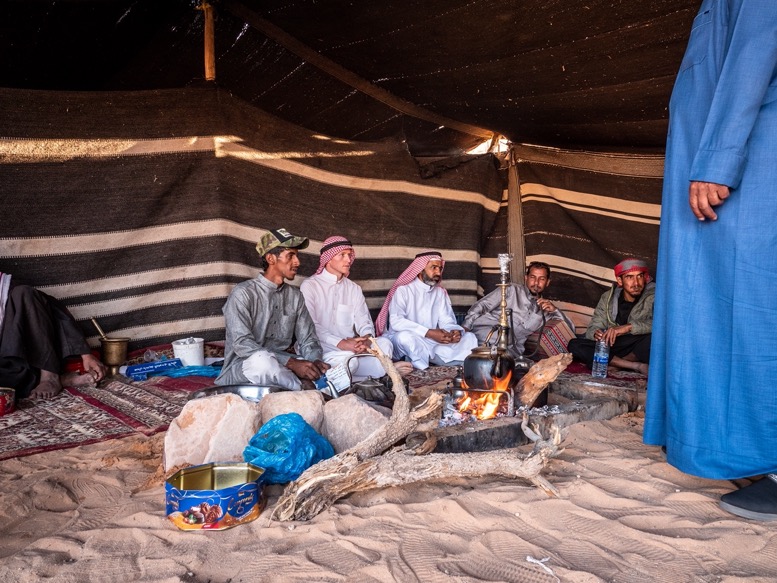


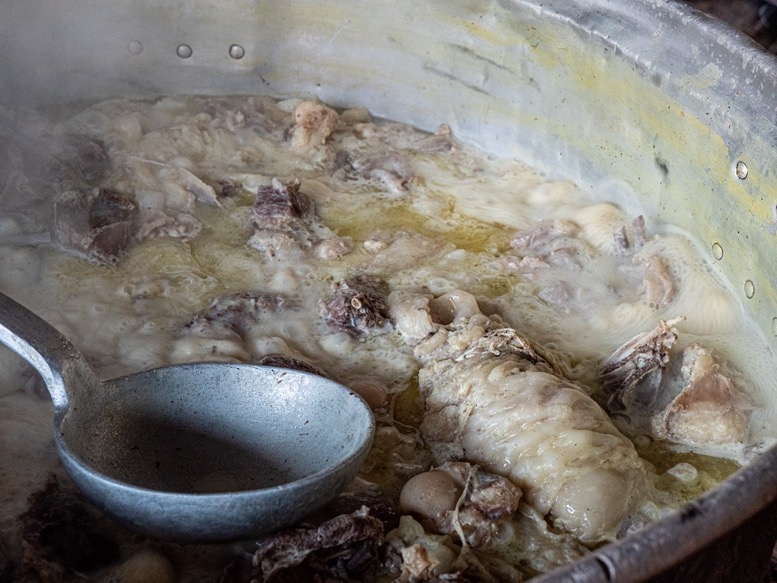
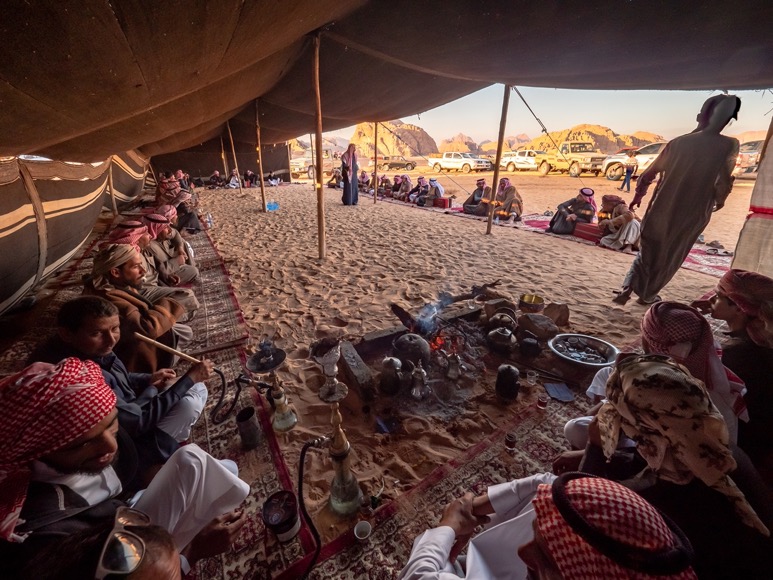



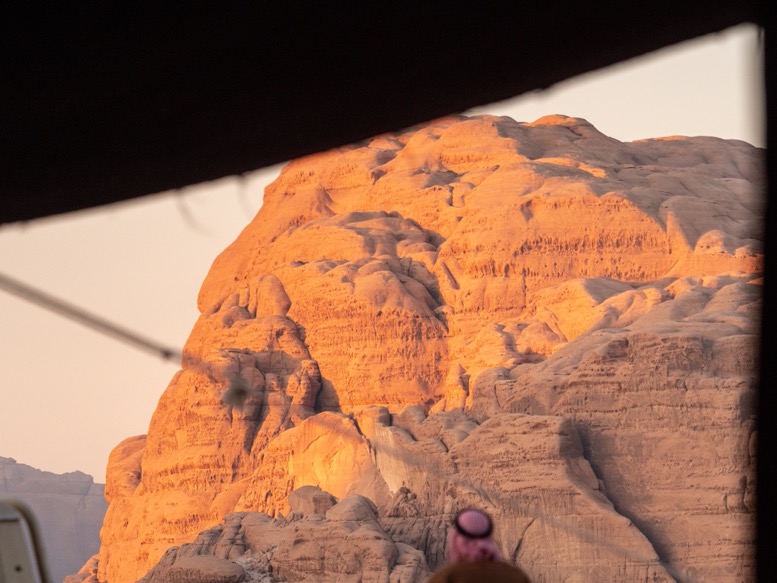
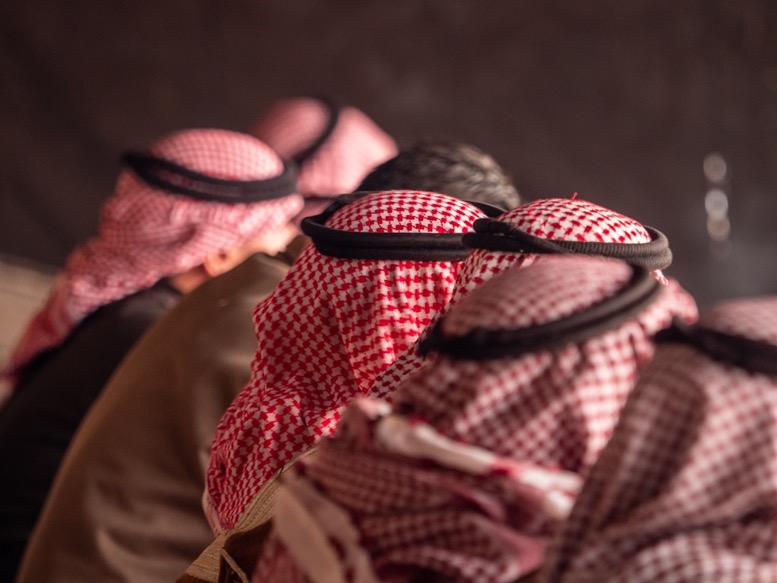
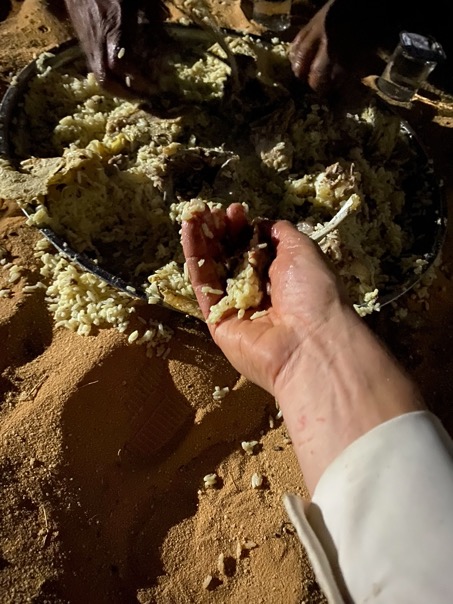
\\ November 18 | Day 6: Back
For one last time I joined Getter and Rahed around the fire for some morning tea. The sand was cold in the morning, giving my feet a numb feeling in the walk over from my camp spot a little away from the tent.
The place looked like any other party aftermath: dirty dishes and garbage everywhere. So after tea I joined Rahed with collecting garbage from the area. It already surprised me the day before that everyone just threw everything on the ground. Even though we spent over half an hour non-stop picking up plastic, it was far from perfect, as some of the plastic by now had blown away.
As I walked around on cold bare feet, Rahed, also barefoot, beckoned me over. He spotted a scorpion in the sand. The small 3 centimeter long scorpion was lightly colored, almost transparent. I had already hoped to spot one, and so on the last morning I finally did. A sting however can be deadly, so taking some pictures Rahed dealt with it the Bedouin way: killing it.
We shook off the sand of the carpets, rolled them up and after getting a similar massive load from the women’s tent we drove the overloaded Toyota to town. We dropped off the carpets somewhere, then had a last quick tea at someone’s place before heading to the parking lot with my car. And after one last goodbye Rahed and Getter drove off. My time with the Bedouins and in the Wadi Rum desert had come to an end.
I felt a bit sad seeing them drive off. In the last 2 days they went from being complete strangers to me, to being the 2 people I probably knew best in this country at this moment. For 2 days our lives became intertwined, and now they branched off again, perhaps never to merge ever again.
I could not have dreamed of a more powerful experience than this. I learned a lot about their culture and habits, and with it comes a huge respect for these people and their culture. These people are extremely polite and friendly. They invited a complete stranger into their homes and to a family celebration. Thank you Zalabia family!
